The CATALYST
CHEMISTRY AND BIOCHEMISTRY ALUMNI MAGAZINE FALL 2022
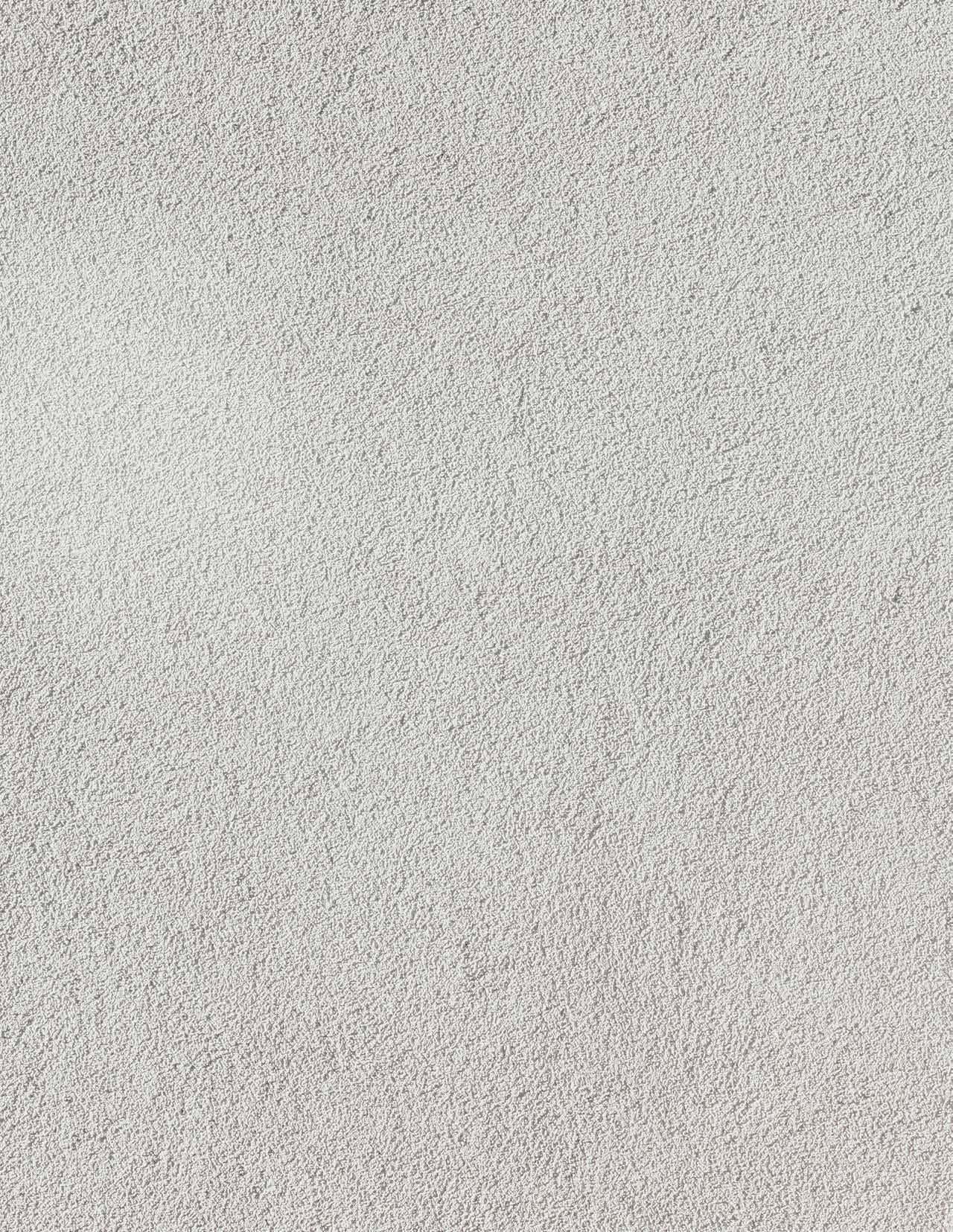
Dr. Linda Mobula-Shufelt, UArizona Biochemistry BS, Class of 2004, health advocate and humanitarian hero.


Page 10
Warrior Scholar Project serves veterans returning to school.
Page 4
DEAR CBC COMMUNITY

As another exciting and eventful year ends, I would like to thank you for your continued support of CBC and our mission! As we reflect on recent years, we are grateful for our students, alumni, faculty, and staff who have continued to excel in the face of unprecedented challenges. In this Catalyst, we share a small sample of the outstanding achievements and accomplishments of our students, faculty, staff and alumni and look forward to the continued opportunities that lie ahead.
Our alumni continue to blaze new trails and reach ever higher in their careers, as highlighted throughout in the “Where are They Now” snapshots. In our cover story, CBC Alumna Dr. Linda Mobula-Shufelt and her world-wide efforts to bring healthcare to the less fortunate are highlighted. Our current students continue to excel and receive numerous department, college, university, and external awards, including the newly established Howard P. Klein Early Career Excellence Award that recognizes outstanding early success in research for graduate students.
CBC faculty research programs continue to exert significant impact on society, as well as a direct and positive impact on the local and state economy. Several examples are provided within the Catalyst, including the Department of Energy, Energy Frontier Research Center led by Prof. Erin Ratcliff and several highlights of CBC Innovations. In service to the community, Dr. Monti and the Warrior Scholars program have helped introduce a new cadre of students to the research ecosystem. CBC personnel continue to translate our discoveries from the faculty research labs into licensing and start-up endeavors, which continue to receive funding and awards.
We welcomed several new faculty and staff hires, including Assistant Professors Marielle Walti and Michael Taylor, Assistant Professor of Practice Juliana Sacoman and Lecturer (and alumna) Tara Archuleta. Professor Elisa Tomat was promoted to Professor of Chemistry and Professor Jean-Luc Bredas was honored with the designation of Regents Professor. The CBC community saw longtime faculty member and MARC program director Prof. Marc Tischler celebrate his retire-
ment. Longtime Catalyst editor and CBC Alumni Coordinator Ellie Warder also entered retirement. We were saddened at the passing of former colleagues Prof. F. Ann Walker and Prof. Don Bourque.

CBC faculty and staff continue to be recognized for their excellence in teaching, scholarship, outreach, and service. Profs. Dollinger, Gianetti, Hidalgo and Pyun were recipients of highly prestigious UA Awards and Professor Pollard was appointed interim Dean of the W.A. Franke Honors College. Our outstanding staff, new and established, continue to elevate the mission of the department, and achieve broad recognition for their contributions beyond the walls of CBC.
We are particularly excited for the coming year as we see many great opportunities ahead, including the long-awaited completion and occupancy of the renovated “Old Chemistry” Building and the newly constructed Commons building with state-of-the-art classrooms and facilities that will house administrative, research, teaching, and student success and support activities, while retaining the style and history of the original architecture.
Thank you for your continuing support of CBC!
Craig Aspinwall Department Head
THE CATALYST | CBC ALUMNI MAGAZINE 2
TABLE OF CONTENTS
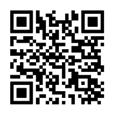

The CATALYST Editor-in-Chief/Contributing Editor & Photographer: Olivia
Associate Editor-in-Chief: Lisa
Creative Editor: Lisa
Senior Editors: Ashley
Roy
Proofreaders:
Lori
De
Contributors:
Ellie
Thank you
all the
and
the
for
We
the
is on the land and
of Indigenous
Today, Arizona is home to 22 federally
the
strives to build
and
Chemistry and Biochemistry at The University of Arizona on: Facebook | Twitter | LinkedIn | Instagram | YouTube Find
Scan
to
We Remember Frances Ann Walker 4 Helping Veterans Succeed in College 5 New DOE Energy Frontier Research Center 6 Old Chemistry Renovation 6 Innovations 7 ACS RMRM 2021 Scorpion Pit Competition 8 Alumni: Where Are They Now? 8 Dr. Linda Mobula-Shufelt, Biochemistry BS, Class of 2004, and Her Journey as a Health Advocate and Humanitarian Hero 10 O’Brien and Klein Scholarships 12 2021–22 Student Awards 13 Faculty Awards & Honors 14 Milestones 15 Staff Awards 16 New Faculty and Staff 17 Retirees 18 In Memoriam 19 CBC by the Numbers 20 Alumni News 21 Alumni Highlight: Keeper Sharkey 39 May 2022 & August 2022 Grads 40 Student Adventures 45 Retirees (Extended) 49 In Memoriam (Extended) 51 2022 in Pictures 52
A. Mendoza
M. Arrotta
Stage
McKinley,
Sanchez
Debra Armand-Cade,
Boyd, Regina Brandt, Carleen
Armon, Peggy Humbert, Laura Lustro, Brooke Massani
Neal Armstrong, Craig Aspinwall, Iman Daryaei, Lisa Elfring, John Enemark, Mary Flores, Paul Lee, Dennis Lichtenberger, Linda Mobula-Shufelt, Oliver Monti, Cindy Neal, Marc Tischler,
Warder
for
support
inspiration from
CBC Community
assisting on making the Alumni Magazine happen.
respectfully acknowledge
University of Arizona
territories
peoples.
recognized tribes, with Tucson being home to the O’odham and the Yaqui. Committed to diversity and inclusion,
University
sustainable relationships with sovereign Native Nations and Indigenous communities through education offerings, partnerships,
community service.
Alumni News and more in the online magazine cbc.arizona.edu/alumni/catalyst
with your camera phone
visit the site
FRANCES ANN WALKER
Professor Emeritus d. January 30, 2022
by Mary T. Flores, Retired
On January 30, 2022, the world lost an amazing scientist and pioneer in Bioinorganic Chemistry, a caring teacher, a role model and mentor, a world traveler, a woman of faith, and a loving friend.

Ann was preceded in death by her parents, Robert W. and Marian S. Walker of Adena, Ohio. She was the oldest of five children and survived by her siblings Elizabeth W. “Betty” Campbell, Robert A. “Bob” Walker, David W. Walker (wife Bobbi) and Janet M. Walker (wife Kathy). She also had many nieces and nephews and countless colleagues, students, and friends.
“I first met Ann in the early 1970s, and she joined the faculty at The University of Arizona in 1990. She was always a voice for excellence— in her own activities and in those of colleagues and students. Her presence at our joint weekly research group meetings made them stimulating and productive for everyone.”
— John Enemark
Ann Walker’s service to the Department of Chemistry and Biochemistry at the University of Arizona began in 1990. I started working as her Assistant in 1998. It was Ann’s birthday, so her lab members and students came together to celebrate. The get-together also served to welcome me and introduce me to my new family.
My association with Ann will influence my life forever. And working alongside her gave me the opportunity to watch her change many lives. Ann was my boss, my colleague, my friend, and a fellow animal lover. Ann became my supporter who always had my back and offered encouraging words. She was straightforward, honest, and did not sugarcoat the reality of things.
“Ann was a force for science. She had many interests, adored her dogs, and loved traveling—but her energy for science was truly formidable. Her impact continues through her impeccable papers and the work of all her trainees and collaborators around the world. One of my favorite memories of Ann took place as we wandered around an evening poster session together a few years ago: Ann kept asking really tough questions to those late-night poster presenters!”
— Elisa Tomat
I joined the ranks of many who were constantly in awe of the depth and breadth of Ann’s knowledge. One day, Ann humbly said that she was a success in part due to serendipity. She felt that several of her innovations came about because she made sure that she was in the right place at the right time and remained ready to find interesting and unexpected things.
Ann’s research group studied a wide range of bioinorganic and biological systems to gain a better understanding of heme proteins that are necessary to the life of most living organisms. She examined proteins in bloodsucking insects and cytochromes that transfer energy between cells. Her work included the study of porphyrins and their complexation with iron, which allowed her to obtain structural information about metal binding proteins. She relied on advanced spectroscopic methods of various kinds. Her research produced unprecedented understanding of the electronic and molecular structures of these systems.
“I was always full of awe and admiration for Ann. Aside from her scientific accomplishments, I was impressed by her many years of service for the Journal of the American Chemical Society. I was convinced that she often knew more about the physical methods and biochemistry of the submissions than the authors and reviewers. I also appreciated her unbounded love, care, and support for her students. But what comes to mind most vividly when I remember Ann is the smile with which she greeted everyone that made them feel like an accepted part of her family. ”
—Dennis Lichtenberger
Ann always understood the value and impact of mentoring relationships. During her remarkable career, she directed 24 MS students, 10 PhD students, numerous postdoctoral associates, over 120 undergraduates, as well as 7 high school teacher and student projects. She was always invested in and enjoyed being part of others’ success.
One of Ann’s proudest moments was when she was inducted as a University of Arizona Regents Professor in 2000.
Ann’s work was recognized locally, nationally, and internationally. She believed in including others when she celebrated her successes. Her numerous Awards and Honors include:
• Associate Editor, J. Am. Chem. Soc., 1998-2010
• Recipient, Francis P. Garvan-John M. Olin Medal, American Chemical Society, 2000.
• Alfred Bader Award in Bioinorganic Chemistry, American Chemical Society, 2006
• Chair, Division of Inorganic Chemistry, American Chemical Society, 2010
• Elected Fellow, American Chemical Society, 2011
After Ann’s retirement in 2013, she continued to be an active contributor to the mission of the Department of Chemistry and Biochemistry.
Rest in peace, Ann. You will be in our hearts forever.
THE CATALYST | CBC ALUMNI MAGAZINE 4
WE
Find more In Memoriam stories on page 19.
REMEMBER
HELPING VETERANS SUCCEED IN COLLEGE
Ever since it was signed into law by President Roosevelt in 1944, the G.I. bill has offered millions of American service members an opportunity to further their education, e.g., by enrolling at universities for advanced degrees. The more than one million members currently enlisted in the armed services constitute a sizeable and diverse talent pool whose interests can be stimulated and nurtured by a university education. The transition from the structured and often high-stress environment of active duty to a college campus teeming with young people making their way into adulthood can be disorienting, and the many years away from a school desk or lecture theater often make starting in a degree program challenging.
To help with this, Oliver Monti, Professor of Chemistry and Biochemistry in CBC, runs a science and math boot camp for recently separated veterans and service members who are about to retire from the armed forces. This program, supported by the Veterans Office at UArizona (VETS) and the highly select Warrior Scholar Project, is one of only 22 such programs nationwide, and seeks to empower enlisted veterans and service members to successfully transition into and pursue higher education.


Every summer, a cohort of veterans spends two intense weeks on campus focused on an introduction to humanities and STEM classes. For the STEM week, the Scholars receive a crash course in math, before sitting daily in a fast-paced mock introductory physics class. By modeling different lecture styles and discussing methods for studying effectively and seeking help, the Scholars learn how to navigate the
campus environment and take advantage of its support infrastructure. This intensive class experience is supplemented by extended homework and a mixture of laboratory tours and engaging big picture science talks. The Scholars are also enrolled in a week-long research project, which sees small teams embedded in research labs to experience research and person-to-person mentoring firsthand, highlighting the strengths of an undergraduate education at UArizona in general and CBC in particular.
“The Warrior Scholar Project week is among the most rewarding teaching experiences every year,” says Monti. “The Scholars are highly motivated and on fire, and I can’t think of a population of students more deserving of our support.”
Veterans who attend the University of Arizona have the opportunity to apply to the Arizona Science, Engineering and Math Scholars Program for Veterans (ASEMS-V). This program, led by CBC Associate Professor Michael Marty, supports ASEMS-V students who are pursuing a STEM degree with continued mentoring and research opportunities toward a career in STEM. Both Marty and Monti are delighted to help veterans find a path to their second career, and proud to be leading these initiatives at UArizona.
5 DEPARTMENT OF CHEMISTRY AND BIOCHEMISTRY | FALL 2022
The 2022 Warrior Scholars visiting LabMontiTM
Warrior Scholars research team in action
“The Warrior Scholar Project week is among the most rewarding teaching experiences every year”
Photo credit: Sara Zachritz
Photo credit: Sara Zachritz
NEW DOE ENERGY FRONTIER RESEARCH CENTER
 By Neal Armstrong
By Neal Armstrong
The University of Arizona was recently selected as the lead institution for a new $11M, fouryear Energy Frontier Research Center by the Department of Energy—The Center for Soft (Photo) ElectroChemical Systems (SPECS). The Center will be led by Erin Ratcliff (Chemical and Environmental Engineering and Chemistry/Biochemistry), and including UA PIs (Neal Armstrong, Jean-Luc Bredas, Adam Printz) and PIs from the National Renewable Energy Laboratory, University of Colorado-Boulder, Georgia Institute of Technology, Stanford University, Purdue University, Emory University, and the University of Kentucky.
SPECS was selected after a fierce competition, along with 42 other new or renewed DOE Basic Energy Sciences EFRC programs, with more than $400M in total designated to support multi-disciplinary scientific teams led by 28 universities and nine National Laboratories, with more than 75 additional partner institutions. These EFRC programs will tackle the toughest scientific challenges preventing advances in energy technologies underpinning everything from energy storage to quantum information science.
SPECS is unique in the U.S. in its focus on the exploration of new, “soft” polymeric materials envisioned for use in both energy storage (battery) and in the formation of “fuels (H2) from
sunlight.” Both technological areas, based on inexpensive, scalable materials, are predicted to be important components in the U.S. energy portfolio by 2050, or much earlier, but significant “knowledge gaps” remain which will be the focus of SPECS research activities.

This award is particularly significant since Professor Ratcliff is in part a product of the DOE EFRC programs started in 2009, where she was a Research Scientist in addition to being a Research Assistant Professor in the UA Center for Interface Science/Solar Electric Materials (CIS-SEM), centered in CBC from 2009-14. As a result of her activities and scholarly contributions in that EFRC program, she was selected by DOE for a “Ten at Ten” award in 2019 as one of DOE’s ten most impactful researchers in the first 10 years of DOE EFRC programs nationwide. After the conclusion of CIS-SEM, Erin joined the College of Engineering in a tenure-track position where she is now an Associate Professor, supervising graduate students and undergraduates from both the College of Engineering and the College of Science. She is also co-Director of the Institute for Energy Solutions.

OLD CHEM RENOVATION
The architects succeeded in preserving the historic building façade and character, while upcycling the interior to enable modern needs.
When completed in January 2023, the two buildings will include a combined 78,600 square feet of academic space. The renovation of the Old Chem Building includes state-of-the-art core research facilities, including a visualization cave for immersive virtual reality
learning. The building will be configured with four collaborative classrooms, departmental and advising offices and workspaces, and three teaching studios for online instruction.

Read the Fierce Education Online article about the renovation’s collaborative learning features
South side addition artist’s rendition. At left is the historic section of the Chemistry Building; at right is “The Commons”— a new facility dedicated to collaborative learning and research.
THE CATALYST | CBC ALUMNI MAGAZINE 6
Erin Ratcliff
Photo credit: Emily Dieckman
INVENTOR OF THE YEAR: ROBIN POLT
The Inventor of the Year award honors a UArizona innovator who has demonstrated a significant commitment to commercialization throughout their career, with a focus on activity in the past year.
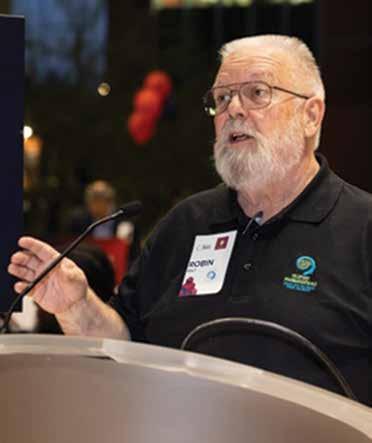
In his time at UArizona, Dr. Robin Polt and his colleagues have launched two startups to commercialize inventions he has co-developed: GlycoSurf and, just in the past year, Teleport Pharmaceuticals.

Teleport Pharmaceuticals LLC, develops glycopeptide drugs that penetrate the blood-brain barrier for the treatment of degenerative neurological diseases and
conditions. Inventors not only include professor Robin Polt, but also associate professor M. Leandro Heien, associate professor Torsten Falk and associate professor John Streicher. Their roles cross multiple colleges and institutes, including the College of Science, the College of Medicine–Tucson, the College of Pharmacy and the BIO5 Institute.
STARTUP OF THE YEAR: CARBENIUMTEC
Congratulations to Dr. Thomas Gianetti and Dr. Jules Moutet, University of Arizona researchers, for winning Southern Arizona’s Startup of the Year from the Arizona Technology Council!
Their company, Carbeniumtec, was founded in 2020 and uses a symmetric system with a single organic material as both anolyte and catholyte, which is key to improving the performance, cycle life, and energy density of organic redox flow batteries. Carbeniumtec’s invention leads to an inexpensive, robust, and environmentally sustainable technology for long-duration energy storage. Most recently, Drs. Gianetti and Moutet developed a metal-free electrolyte
that they plan to use to make nontoxic batteries that can store large amounts of electricity—technology they hope helps solve a persistent challenge with renewable energy: where to store the energy before it gets used.
See Arizona Public Media video about CarbeniumTec
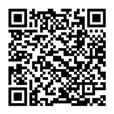
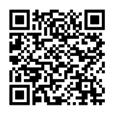
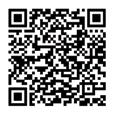


Read TLA story about CarbeniumTec

7 DEPARTMENT OF CHEMISTRY AND BIOCHEMISTRY | FALL 2022
INNOVATIONS Read TLA article: UArizona celebrates 10 years of innovation, commercialization and impact
Photo credit: Tech Launch Arizona
LAUNCH
CBC STATS FY2022 2 startups launched | 14 US patents issued | 50 US patents filed 33 invention disclosures | 10 licenses & options executed
Robin Polt at Tech Launch Arizona award ceremony
TECH
ARIZONA
Photo credit: Paul Tumarkin, Tech Launch Arizona
Thomas Gianetti (right), assistant professor in the Department of Chemistry and Biochemistry and co-founder and chief executive officer of CarbeniumTec, chats with Jules Moutet in the team’s lab.
ACS RMRM 2021 SCORPION
PIT COMPETITION
By Iman Daryaei, PhD, ACS RMRM 2020 Program Co-Chair
Innovation in all fields of chemistry combined with entrepreneurial activities has led to the development of new businesses and the creation of jobs and value for society. To feature the most pioneering research and ideas or business plans in the field of chemistry by members of the chemistry community in Southern Arizona, entrepreneurs from academia, industry, or non-profit organizations in all academic/ industry levels were invited to participate in a pitch competition called the Scorpion Pit.
The first competition of its kind held at an American Chemical Society (ACS) meeting, the Scorpion Pit was part of the 2021 Rocky Mountain Regional Meeting held in Tucson, Arizona, and organized by the Southern Arizona Local Section and Dr. Iman Daryaei. The competition meshed well with the ACS goal for inclusivity of industrial members, providing a venue for showcasing chemical industry innovation and supporting chemical industry professionals to shape the technologies of today and tomorrow.
The winner received a $1,300 grant and an opportunity for real-life funding from interested Scorpions, local experts with knowledge and experience in chemical industries, business development and finance, and entrepreneurship. They also won a spot in the University of Arizona


6-week NSF I-Corps local cohort training course to support the development of the winning idea and advance the field of chemistry. Five startup companies competed in the Scorpion Pit:
• Carbeniumtec, a startup company with focus on renewable energy storage— founded by Dr. Thomas Gianetti
• Iron Shell Material Technologies, a startup with focus on New, Green, Carbon-negative Materials for Construction and Energy Industries—founded by Dr. David Stone
• Scintillation Nanotechnologies, with focus on nanoparticle radioisotope detectors for use in basic research and drug discovery labs—co-founded by Drs. Colleen Janczak and Craig Aspinwall


• Teleport Pharmaceuticals, with focus on glycopeptide drug—co-founded by Drs. Robin Polt, M. Leandro Heien, and Torsten Falk

• uPetsia, with focus on developing bacteria that generate mint aromas, for use in dog food and treats—co-founded by Scott Zentack and Eric Lyons
The startups were scored based on their capabilities in team, problem/ solution (technology), market, IP, and overall impression of their pitches. In a very close race, Carbeniumtec was announced as the winner! Iron Shell Material Technologies won the people’s choice award that was directly selected by the audience.
SCORPION PIT COMPETITION SPONSORS
GOVERNMENT
I
Lano Balulescu, USAF, Dept of Defense
Amy Glynn, FDA, Compliance Officer
Danny “DJ” Morales, U.S. Dept of Homeland Security
GRADUATE SCHOOL
I just entered my third year in a chemistry PhD program at Stanford University, where my concentration is in biophysical chemistry. — Steven Fried
Christina Huynh, University of Pacific, Clinical Nutrition
Heber Lara, University of Washington, Immunology
Monica Ruffalo, University of Arizona, Special Education
THE CATALYST | CBC ALUMNI MAGAZINE 8
work as an epidemiologist for the CDC’s Overdose Data to Action grant within the Maricopa County Department of Public Health in Phoenix. — Mary-Helen Wanat
Ahmad Luqman Afiq Abdullah, Science Officer
ALUMNI: WHERE ARE THEY NOW
HEALTH PROFESSIONS
After 35 years as an Internist and then Rheumatologist, I am happily retired in Mesilla, New Mexico, surrounded by pecans and cotton. — Armando Angel
James Kudrna, Orthopedic hip surgeon
Craig Sheedy, SCP Health, Northwest Med Center in Bentonville, AK, Asst. med director
Mark Lessner, Lake Havasu City, physician & pediatrician
Tommy Szeto, Phlebotomist
INDUSTRY
I am working for Sherwin-Williams doing chemistry R&D. I got my Master’s Degree in Materials Science and Engineering from the University of Texas at Arlington in December of 2021. — Hunter Pitts
Armando Cardenas, Pfizer
Denisse Divine, GenMark Diagnostics
Daniel Dokuchitz, Linde Electronic Gases & Specialty Products
Spencer Carey, Chevron Phillips Chemical Co.
BUSINESS OWNERS
In July 2020, I founded Pillar Imaging (Littleton, MA), which has subsequently acquired Hampshire Controls (Dover, NH), a leading supplier of cryogenic backup systems and temperature, humidity, pressure, and air flow monitors and alarms for the biotechnology, pharmaceutical, medical, and manufacturing industries —Dr. Michael Pilon
John Nestor, EuMederis Pharmaceuticals, Inc. CEO
Larry Schwartz, IP Business-tech Solutions
Jerry Slightom, AureoGen Biosciences Inc. co-founder
ACADEMIA
I’m excited at the opportunity to run my own research group and keep an eye out for the Lopez lab coming sometime between 2025-2027. I appreciate the opportunities provided by the Chemistry and Biochemistry department during my time at UA that contributed to my success in science. — Kyle Lopez
Michael Ferracane, University of Redlands, Associate Prof., Chemistry & Biochemistry
Tori (Lani) Hidalgo, University of Arizona, Assistant Prof. of Practice, Chemistry & Biochemistry
Jani Ingram, Northern Arizona Univ. Regents Prof. Chemistry & Biochemistry
Metin Karayilan, Case Western Reserve Univ, Assistant Prof. Chemistry
Find Alumni News and more in the online magazine: cbc.arizona.edu/alumni/catalyst

9 DEPARTMENT OF CHEMISTRY AND BIOCHEMISTRY | FALL 2022
DR. LINDA MOBULA-SHUFELT BIOCHEMISTRY BS, CLASS OF 2004, AND
HER JOURNEY AS A
HEALTH ADVOCATE AND
HUMANITARIAN HERO
By Olivia A. Mendoza
Dr. Mobula-Shufelt is currently a Senior Health Specialist with the World Bank. She formerly served as a Public Health and Infectious Disease Advisor with the former Office of Foreign Disaster Assistance at the United States Agency for International Development (USAID). She also worked as a Hospitalist Physician with Johns Hopkins Community Physicians and is currently an Assistant Professor at the Johns Hopkins School of Medicine and Research Associate at the Johns Hopkins School of Public Health.
Dr. Mobula-Shufelt is serving as the Regional Surveillance Disease Enhancement (REDISSE IV) Regional Co-Team Leader for West and Central Africa, where she is working on improving preparedness for outbreaks. She served as the technical lead for the 10th Ebola outbreak in the Democratic Republic of the Congo (DRC) with the World Bank from 2019-2020. This outbreak was the largest in DRC, and challenging since it oc-
curred during a time of conflict. As part of Dr. Mobula-Shufelt’s work with the former Office of Foreign Disaster Assistance (OFDA), which is now the Bureau for Humanitarian Assistance, she served as Public Health Advisor and Deputy Team Leader for the USAID/OFDA Ebola Disaster Assistance Response Team (DART) in Guinea during the West Africa Ebola outbreak, and subsequently served as the Acting Senior Humanitarian Advisor for the USAID/OFDA Ebola response. She had previously provided clinical care to Ebola patients in Monrovia, Liberia, at the ELWA-2 Ebola Treatment Center with Samaritan’s Purse during the summer of 2014. From 2014-2017, she was the Co-Principal Investigator for the Gates-funded Ghana Access and Affordability Program, which aims to improve access to treatment for Non-Communicable Diseases.
While in Liberia, Dr. Mobula-Shufelt’s colleague, Dr. Kent Brantly, was the first American to contract Ebola. She says of her experience, “He had been treating patients in Monrovia in the summer of 2014, at a time when there was limited international assistance. Treating a colleague was quite an overwhelming experience. He was a physician like me and he had a family.

THE CATALYST | CBC ALUMNI MAGAZINE 10
Photos courtesy of Linda Mobula-Shufelt
I thought he was going to die, and his family would lose him. At the time, we were all overcome by fear because nobody truly understood how the outbreak would spread. There was no proven cure and the case fatality rate was extremely high. I was the first to administer ZMapp, an experimental treatment that had only been given to monkeys in a laboratory setting. Since then, ZMapp and other experimental treatments were tested in a clinical trial. Dr. Brantly did recover. I have since spent time with him and his family where we reminisce about those challenges.”
Dr. Mobula-Shufelt also served as the Chief Medical Officer for the Samaritan’s Purse response to the 2013 Typhoon Haiyan in the Philippines and was the Senior Program Manager for the UNHCR funded Samaritan’s Purse European Refugee Response in Greece in 2016. She previously worked in the Office of HIV/AIDS at USAID providing technical assistance to South Sudan, DRC, Mozambique, and Burundi.
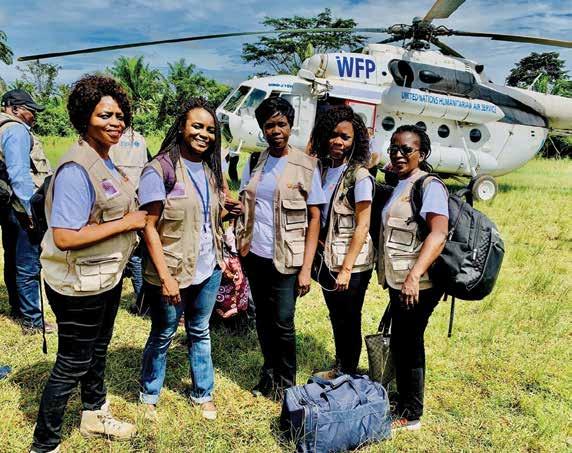
Dr. Mobula-Shufelt shared, “I’m a first-generation American. My family is originally from the DRC. My parents moved to Arizona right before I was born and my father attended the University of Arizona, getting a Masters in Agricultural Economics and PhD in Economics.” When she was 9 years old, the family moved to Kinshasa, the capital city of DRC. A civil war broke out seven years later when the government was overthrown and rebels shut down access to water and electricity. While Kinshasa was largely spared from the conflict, the experiences of fear and desire to help others stuck with her.
Dr. Mobula-Shufelt returned to the U.S. for college and medical school, but she knew she wanted to practice in low-income settings. She obtained a Bachelor of Science with Honors from the University of Arizona in 2004 and participated in the Maximizing Access to Research Careers (MARC) Program from the University of Arizona, graduating in 2004, followed by medical school at the University of California, San Francisco. She obtained a Masters in Public Health from the Johns Hopkins Bloomberg School of Public Health with a concentration in Health in Crisis and Humanitarian assistance. Her medical residency in Internal Medicine took place at Johns Hopkins Bay-
FROM LINDA
Iam thankful for my time at the University of Arizona where I received an incredible education and was mentored by amazing faculty. I am so thankful for the late Dr. Michael Wells, who graciously allowed me to work in his laboratory during my undergraduate years. I met him while taking a summer course my freshman year and he emphasized the importance of conducting research very early on. The Wells Lab in the Department of Biochemistry and many members of the Department (like Olivia Mendoza, James Pennington, April Stonehouse, and others) have continued to encourage me through the years and have been my biggest cheerleaders. Dr. Marc Tischler (MARC Program) and Dr. Carol Bender (UBRP) are other examples of incredible mentors that provided great support. I look back at my time at the University of Arizona with great fondness. It was a launching pad for a career of service in the area of humanitarian assistance and global health work. I would also like to thank Dr. Roger Fox, a Professor from Agricultural and Resource Economics, my father’s advisor, who also mentored me on how to pursue a career in International Development.
view Medical Center, and she went on to complete a Post-doctoral Clinical Research Fellowship at Johns Hopkins Hospital.
When Haiti suffered a devastating earthquake in 2010, Linda was compelled to volunteer her medical skills. She was moved by the patients she treated in Haiti’s largest slum, Cite Soleil. One of her trips coincided with the onset of a cholera outbreak, affecting thousands of Haitians. The cholera outbreak in Haiti was the perfect storm, occurring months after the devastating earthquake in areas with poor sanitation such as Cite Soleil. Cite Soleil was recently featured in the media when hundreds of individuals were killed as a result of gang violence. Dr. Mobula-Shufelt eventually moved to Haiti for a year, where she managed a primary care clinic, treated cholera patients, and established a maternal and child health program. She quickly realized she needed training in public health to have a broader impact in communities, in addition to helping at the individual level as a clinician.
Linda is now married and recently gave birth to a daughter, Trinity Grace Imani, in March of 2022. She and her family reside in both Kinshasa, DRC, and Montreal, Canada.

11 DEPARTMENT OF CHEMISTRY AND BIOCHEMISTRY | FALL 2022
Photos courtesy of Linda Mobula
James and Linda
Linda (second from left) with Annie, Dr. Dorothee, Dr. Emilia, and Dr. Imaculée in Ituri, DRC, as DRC Ministry of Health, World Bank, WHO, and CDC respond to Ebola outbreak, September 2019
O’BRIEN AND KLEIN SCHOLARSHIPS

DAVID F. O’BRIEN GRADUATE FELLOWSHIP IN CHEMISTRY
The O’Brien Graduate Fellowship is approaching 20 years in support of CBC Graduate Students. This Scholarship was established by family, friends and colleagues in memory of David F. O’Brien, who was a professor in the Department of Chemistry at the University of Arizona. Dr. O’Brien loved his work and was a highly respected scholar and colleague. He also was a devoted teacher and mentor. The David F. O’Brien Fellowship is awarded to students who have completed their third year of graduate studies for outstanding research perfor-
mance. The Fellowship supports travel to interdisciplinary scientific meetings, such as the Gordon Conference.

Professor O’Brien’s research emphasis was focused on the chemistry and biochemistry of self-assembled nanostructures and polymerized surfactant assemblies. The fellowship in his honor is awarded to a Chemistry or Biochemistry graduate student who has demonstrated the ability to carry out independent research in a scholarly and enthusiastic way.
The David F. O’Brien Graduate Fellowship was awarded at the 9th Annual CBC Research Symposium held in August of 2022. We were very excited that Nancy O’Brien was able to participate and to meet the 2022-2023 Fellow, Tasmia Ahmed, from the Lee Research Group.


HOWARD P. KLEIN EARLY CAREER EXCELLENCE AWARD
The Klein Early Career Excellence Award was established in Fall 2022 from a generous gift by CBC alumnus Howard P. Klein, Chemistry PhD, class of 1968. This award is provided to Chemistry or Biochemistry graduate students who have demonstrated extraordinary success in research early in their graduate career in CBC. Students completing their first or second year of graduate studies are eligible.
The inaugural recipient of the Howard P. Klein Early Career Excellence Award is Rajat Ravi from the Ziurys Research Group. He was selected August 2022 at the 9th Annual CBC Research Symposium.
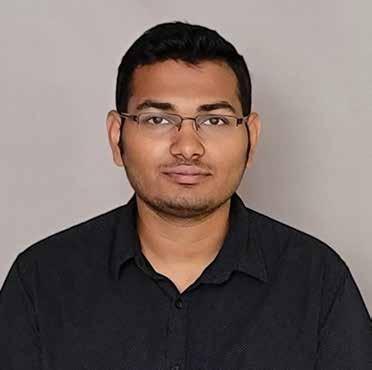
THE CATALYST | CBC ALUMNI MAGAZINE 12
L–R: Tasmia Ahmed (recipient), Nancy O’Brien, and Devin Seka and Alessandra Fistrovich (applicants)
Read CBC information about the O’Brien Fellowship
Tasmia Ahmed, awardee of the David F. O’Brien Graduate Fellowship in Chemistry Rajat Ravi, awardee of the Howard P. Klein Early Career Excellence Award
Photo credit: Lisa Arrotta
2021–22 STUDENT AWARDS
GALILEO CIRCLE SCHOLARS
Undergraduate Students
Elizabeth Browne
Michael Cusanovich Scholar
Julie Fan
Shifat Hossain
Shayna Maddern Madeleine Milner
Nick Mortimore
Sami Muslmani
October Owen
Kristen Roehling Vara Vungutur Hayley Wondra
Graduate Students
Tasmia Ahmed
Michael Cusanovich Scholar Jianhua Bao
Natasha Rose Cornejo
Paola Cruz Flores
Michael Cusanovich Scholar
Jeffrey Groch
Md Mubarak Hossain
Kushani Kananka Hewage Nicholas Lauta Anjalee Wijetunge
UNDERGRADUATE AWARDS
Chemistry and Biochemistry
Outstanding Senior Kiah Sleiman - Biochemistry
Chemistry and Biochemistry Excellence in Research
Ciara Zak - Biochemistry
Chemistry and Biochemistry Outstanding Senior Fall 2021
Amanda Gong - Biochemistry
CBC Outstanding Juniors
Nick Mortimore - Biochemistry
October Owen - Chemistry
CBC Outstanding Sophomore Truc Le - Biochemistry
CBC Outstanding Freshman Jackson Taylor - Biochemistry
CBC Outstanding Senior Thesis
Arturo Lujan 1st Place
Rorie Robinson 2nd Place
ACS Hach Scholars
Meghan Davis Devyn Debrosse
Undergraduate Award in Analytical Chemistry
October Owen 2022
Dominic Dobai 2021
Undergraduate Award in Physical Chemistry
Kristen Roehling
Charles Hoyt Scholars
Julie Fan Truc Le
Excellence in Biological Sciences Scholars
Julie Fan Shifat Hossain Hayley Wondra
Michael A. Wells Research in Biological Sciences Scholars
Julie Fan Shifat Hossain Hayley Wondra
AZ Society for Coatings Technology Scholars
Taiya Alvarez-Williams Christian Viramontes
Lela E. Booher Memorial Scholar Madeleine Milner
Dr. Thomas M. and Candace C. Grogan Scholars
Alexis Cruickshank-Taylor Meghan Davis Ryan Wang
Patrick M. Hefferan Memorial Scholar
October Owen
Royal Society of Chemistry Certificate of Excellence Award October Owen
CBC Outstanding Student Peer Mentors
Shifat Hossain Giang Huong Pham
Ronald Gonzalez Wildcat Spirit Awardees
Estevan Cleveland Melina Leal Shayna Maddern
Vivian Mendoza-Leon Kiah Sleiman Zach Stebner
GRADUATE AWARDS
Outstanding Graduate Students Outstanding Scholarship
Tarek H. El Assaad Outstanding Service
Holly Anne Sofka
Outstanding Teaching Brittany Stankavich
Carl S. Marvel Scholars
Tarek H. El Assaad
Anjalee Wijetunge
David O’Brien Graduate Fellows Md Mubarak Hossain Yu-Shien Sung
Victor P. Thalacker Chemistry Graduate Fellow Nicholas Lauta
Kathryn K. and James D. Steele Scholar
Natasha Rose Cornejo Herbert E. Carter Award Tasmia Ahmed
Dr. Wayne Cody Scholars in Medicinal Biological Chemistry Nicholas Lauta Kevin Schofield
George Gregson Scholars Rashmi Amarakoon Tapasyatanu Dash Christopher Marshall Rajat Ravi Trishal Zaveri
John Hostetter Scholar Devin Seka
Early Career Excellence in Graduate Research
Levi Brown
Devin Pontigon, runner up
SPECIAL RECOGNITION
2022 ACS Division of Analytical Chemistry Graduate Fellow Julia Townsend
2022 Merck Research Award for Underrepresented Chemists of Color Md Mubarak Hossain
UofA Dean of Students Robert Logan Nugent Senior Award
Trevor Tankersley
UA Beckman Scholar Nick Mortimore
Danny Brower Memorial Scholar Shifat Hossain
CBC Undergraduate Poster Fair
Senior Thesis
1st: Arturo Lujan 2nd: Joshua Stanton
Biological Sciences Advanced 1st: Cristian Chavira 2nd: Nick Mortimore
Biological Sciences Emerging 1st: Vanessa Addison 2nd: Aunita Hakimi
Physical Sciences Advanced 1st: Parker Geffre
2nd: Greg Clarke
Physical Sciences Emerging 1st: Natalya Stanisic 2nd: Kawthar AlElg
Honorable Mentions Abel Cherian Joshuar Goldring Dorien Haney Avani Kumar Cong Hieu Pham Amanda Platt
Matthew Schott
Trevor Tankersley Franky Torres Yuyin Wang
Biological, Engineering, Chemistry, Undergraduate, Research Poster Fair Winners, Excellence in Undergraduate Research
Isabelle Mundo
Natalya Stanisic Allison Tulino
13 DEPARTMENT OF CHEMISTRY AND BIOCHEMISTRY | FALL 2022
FACULTY AWARDS & HONORS
AWARDS
Lisa Dollinger
Gerald J. Swanson Prize for Teaching Excellence

Congratulations to Associate Professor of Practice Lisa Dollinger who is a recipient of one of the UA Awards of Distinction. Dr. Dollinger was selected for the Gerald J. Swanson Prize for Teaching Excellence. This award is designed to recognize excellence in undergraduate teaching at the University of Arizona.


Thomas Gianetti
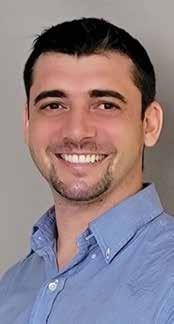
University Early Career Scholars Award University Early Career Innovation & Entrepreneurship Award
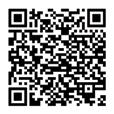
Congratulations to Dr. Gianetti who was selected for both the University Early Career Scholars Award and the University Early Career Innovation & Entrepreneurship Award. The Early Career Scholars Award was established to acknowledge outstanding early-career faculty who are at the forefront of their disciplines and make highly valued contributions to the teaching, creative activity, and service priorities set out in the University’s Strategic Plan.
The University Early Career Innovation & Entrepreneurship Award was established to acknowledge early-career faculty who have demonstrated significant involvement in expanding the impact of research to the public good through innovation and commercialization.
Tori (Lani) Hidalgo
University of Arizona Foundation

Leicester and Kathryn Sherrill Creative Teaching Award
Congratulations to Assistant Professor of Practice Tori Hidalgo for being one of 29 honorees recognized as exemplary faculty during the Inaugural Outstanding Faculty Awards. Dr. Hidalgo received the
University of Arizona Foundation Leicester and Kathryn Sherrill Creative Teaching Award.
Jeffrey Pyun
University Distinguished Innovation & Entrepreneurship Award
We congratulate Dr. Pyun who was selected for the University Distinguished Innovation & Entrepreneurship Award. This award was established to acknowledge those who have demonstrated significant involvement in expanding the impact of research to the public good through innovation and commercialization.
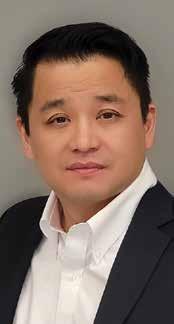
HONORS
Jean-Luc Brédas Regents Professor
Congratulations to Dr. Brédas, who was named Regents Professor in 2022. As defined by ABOR, “The designation of Regents Professor is an honored position reserved for faculty scholars of exceptional ability who have achieved national and international distinction. The title Regents Professor serves as recognition of the highest academic merit and is awarded to faculty members who have made a unique contribution to the quality of the University through distinguished accomplishments in teaching scholarship, research or creative work.”
We are grateful for the contributions of Dr. Brédas to the Department, College, and University.
THE CATALYST | CBC ALUMNI MAGAZINE 14
Lisa Dollinger
Thomas Gianetti
Tori Hidalgo
Jeffrey Pyun
Jean-Luc Brédas
Read UA News article about Regents Professors
John Pollard
Professor of Practice
John Pollard was appointed as Interim Dean of the W.A. Franke Honors College, effective July 1, 2022. He was the Associate Dean for Academics and Curricular Innovation at the W.A. Franke Honors College as well as Professor of Practice in the Department of Chemistry and Biochemistry.

In his 21 years as an educator at the University of Arizona, Dr. Pollard has received numerous awards for his excellence in teaching and curricular development, and he co-authored the nationally recognized Chemical Thinking curriculum—a prominent part of introductory chemistry courses at the University of Arizona as well as institutions around the world.
Read about Dr. Pollard’s appointment as Interim Dean

MILESTONES








Elisa Tomat
Professor of Chemistry and Biochemistry
Elisa Tomat’s promotion to Professor of Chemistry and Biochemistry was approved in 2022.
Dr. Tomat has played an integral role in research, teaching, mentoring, service, and outreach within the Department, College, and University, as well as to the local, national and international scientific communities.
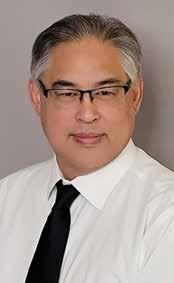
Visit our website: cbc.arizona.edu/alumni/catalyst
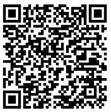
“35 years and counting. It has definitely not felt like 35 years. This job has kept me feeling younger than my age because I still enjoy working with students and post-docs and the occasional professor who wanders into my lab—you know, anyone younger than me. I have also enjoyed doing educational outreach for elementary and middle school students and I hope we get back to doing this again, post pandemic. 35 years ago, I never would have thought that I would be here this long, and I’m looking forward to at least a few more years. I may get to 40, but I’m not making any promises.” —Paul Lee

15 DEPARTMENT OF CHEMISTRY AND BIOCHEMISTRY | FALL 2022
Elisa Tomat
John Pollard
51 years Bonner
43
41
35 years Ludwik Adamowicz Paul Lee Roger
30 years Hollis
20 YEARS
15 YEARS Jennifer Laczny 10 YEARS Dimitris Antoniou Peggy Humbert Steven Schwartz Amanda Wentzel
Denton
years Marc Tischler
YEARS Ellie Warder
Miesfeld
Whitewater
Craig Aspinwall Katrina Miranda
Paul Lee
STAFF AWARDS
2022 DR. HAROLD MCNAIR STAFF AWARDEES
Peggy Humbert and Colleen Kelley

Dr. Harold McNair was a Professor Emeritus of Analytical Chemistry at Virginia Tech University. He was a pioneer in the development of gas phase and liquid phase chromatography as analytical techniques. McNair received his BS in Chemistry at the University of Arizona (1955) and his PhD in Chemistry from Purdue University (1959). His work has received numerous awards, and he is widely celebrated as an outstanding author, teacher, and mentor. In 2008, he was invited to the University of Arizona to receive an honorary alumni award from the Department of Chemistry. During his visit, McNair interacted with Chemistry staff members and was impressed by their depth, talent, and dedication.
McNair proposed giving an annual monetary award for 20 years as a recognition of staff members who, because of their outstanding service, make CBC a better place for all. With gratitude for his generosity, we established this award in his honor. Dr. McNair passed away in 2021.
2022 UA AWARD FOR EXCELLENCE
Brooke Massani
Dr. Brooke Massani, Director of Research Support Services (RSS), was selected as a recipient of the 2022 UA Award for Excellence. The University Awards for Excellence are designed to recognize individual University Staff, Classified Staff, and Appointed Professionals for outstanding achievements and activities beyond normal duties.

Nominees are evaluated on their actions that surpass meritorious performance in their job.
COLLEGE OF SCIENCE EXCELLENCE AWARDEE
Lisa Arrotta
Lisa Arrotta was selected as the winner of the College of Science Excellence Award for CBC. She was presented with this award and honored at the CoSSAC Brunch on April 13, 2022.
“Mrs. Arrotta has performed at the highest level ever since joining CBC in early 2021, after leaving a career in media. Though the functioning of a university and the operations of a large department are by anyone’s standards arguably rather arcane, she quickly familiarized herself with the different stakeholders in the department and continuously sought ways to be effective. She provides the department head and the departmental leadership team with thoughtful advice, input and simply excellent support. Her capacity to attend to dozens of tasks at the same time while always making all her counterparts feel appreciated and valued, regardless of whether they be students, staff or faculty, is truly awe-inspiring. Her professionalism is unfaltering, and we all know to count on her.”
—nomination by Dr. Oliver Monti

THE CATALYST | CBC ALUMNI MAGAZINE 16
2022 McNair Staff Award Winners (L to R) Peggy Humbert and Colleen Kelley
Photo credit: Lisa Arrotta
NEW FACULTY & STAFF
Marielle Wälti Assistant Professor

For my PhD, I decided to become an expert in NMR spectroscopy. I successfully solved the Aβ42 fibril structure, the main component in plaques found in Alzheimer’s patients. I felt the desire to find new ways to interfere with protein aggregation, which is an important route to slow the progression of Alzheimer’s and similar diseases. I joined Dr. Marius Clore’s lab at the NIH to expand my knowledge of basic NMR methodologies with one of the world’s experts and to focus on the study of sparsely-populated intermediate states that play an outsized role in the aggregation processes.
Michael Taylor
Assistant Professor
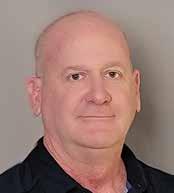
From 2017 through August of 2022, Michael held the position of assistant professor in the Department of Chemistry at the University of Wyoming. Whilst at Wyoming, he developed a research program that is underpinned by an interest in developing organic transformations for use at the chemistry-biology interface. Michael has received an NSF CAREER award, a Thieme Chemistry Journals award, an NIH outstanding investigator award, and a Presidential Scholarly Achievement Award from the University of Wyoming.

Juliana Sacoman
Assistant Professor of Practice



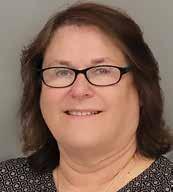
I am originally from Brazil and have lived in 3 states in the US—and AZ is definitely my favorite! I obtained my BS and MSc from Campinas State University (Brazil) and my PhD at Michigan State. I was a research scientist and lecturer in different institutions until I joined the UA community in 2019. I recently accepted a joint appointment with CBC as an assistant professor (career track) that starts in January of 2023. I will be responsible for teaching the BIOC463A laboratory course. Outside of work, I love spending time with my family and dogs, hiking, and traveling.
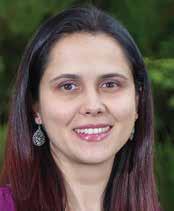

Tara Archuleta Lecturer



I grew up in Tucson and received my bachelor’s degree in Biochemistry and Molecular Biophysics from the University of Arizona before completing my PhD and postdoctoral fellowship at Vanderbilt. I then pursued a Master of Education through the Teach Arizona Program. I taught chemistry and biotechnology at University High School in Tucson, and in 2022 received the Southern Arizona Section of the ACS High School Teacher Award.

17 DEPARTMENT OF CHEMISTRY AND BIOCHEMISTRY | FALL 2022
Debbi Busack Human Resources Generalist
Academic
Estrella Graduate Student Support Specialist Regina Logan Grants Contract Administrator Valerie McClure Human Resources Generalist Ashley McKinley Administrative Support Assistant Kelly Powers IT Services Coordinator Robin Sharfman Business Administrator Post Award Roy Sanchez Administrative Support Assistant
Stephanie Constantino Office Specialist (no photo) Carleen De Armon
Advisor Guadalupe
Kelly Powers
Regina Logan
Robin Sharfman
Valerie McClure
Roy Sanchez
Ashley McKinley
Carleen De Armon
Debbi Busack
Read more about our new faculty and staff in the Catalyst Online: cbc.arizona.edu/alumni/catalyst NEW STAFF
Guadalupe Estrella
IN MEMORIAM
PEOPLE WE HAVE LOST
Don Bourque
Professor Emeritus d. October 12, 2022
Don Bourque, age 79, died on October 12, 2022, peacefully at home in Depoe Bay, Oregon. He grew up in Long Island, New York, son of Philippe and AnnaBelle Bourque.
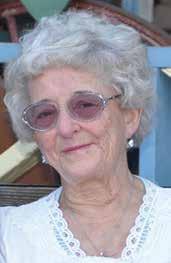
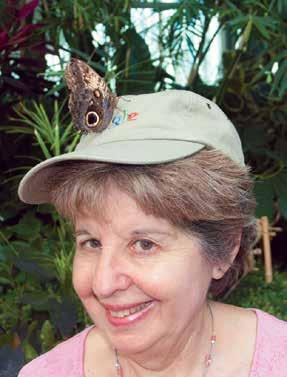
A 1960 graduate of West Babylon High School in New York, he received his BA in Biology from Johns Hopkins University and his MS and PhD in Botany/Zoology/Biochemistry from Duke University. In 1973, Don joined the University of Arizona faculty, serving continuously as a tenured Professor of Biochemistry and Molecular and Cellular Biology until 2011, when upon retirement he became Professor Emeritus.
Don joined the Tucson Symphony Orchestra (TSO) in 1973 and was a member of the TSO bass section until his passing. Don originally trained as a violinist and renewed his violin playing in the mid-1990s. In 1996, he joined the Foothills Philharmonic Orchestra, alternating between bass and violin sections, as well as serving as concertmaster. Don was a proud union member of the American Federation of Musicians.

In 2004-2005, Don was a Visiting Scholar in the U.S. State Department, in the Nonproliferation Bureau, Office of Proliferation Threat Reduction. His work was focused in the Russian Federation, helping to redirect former Soviet biological weapons scientists to develop new therapeutic drugs and vaccines. After completing this assignment, he returned to the University of Arizona and the Tucson Symphony.
Don enjoyed camping and fishing from an early age and especially loved fly fishing with his daughter in Arizona’s White Mountains. Don was the life of the party, loved food, wine and conversation, and will be greatly missed by all those who had the good fortune of knowing him.
Gisele (Rosin) Green MS Chemistry, 1961 d. May 11, 2022
Gisele Green passed away suddenly after a long illness. Born in France, she escaped the Nazi invasion as a young child and settled with her family in New York City. The family later moved to New Jersey, where Gisele attended Drew University. It was there, in the Chemistry Department, that she met her husband-to-be, Maurice. The chemistry between them lasted for 66 years.
Gisele earned an MS degree in Chemistry from the University of Arizona with Prof. Cornelius Steelink in 1961 and then worked as a research assistant with Prof. Gordon Tollin.
Margaret “Marty” Ann Fox Yslas d. January 16, 2022
Marty (Margaret) Yslas passed away on January 16, 2022, at the Tucson Medical Center at the age of 78. Many will remember Marty as the smiling face greeting you at the BSW 3rd floor lobby. Marty is survived by her “Prince Charming” Max Yslas, who was a mail courier for the department, come rain or shine.
Read more about our retirees and about Gisele Green’s and Marty Yslas’s lives in the Catalyst Online: cbc.arizona.edu/alumni/catalyst
19 DEPARTMENT OF CHEMISTRY AND BIOCHEMISTRY | FALL 2022
Thank you for helping us support graduate scholarships, conduct outreach in the community, and for all of your support for the Department of Chemistry & Biochemistry. CBC has succeeded because you gave from your heart, and every penny counts.

Today, we’re asking for your help to ensure that we have the resources to help create bright futures for our students and the world that they influence.
Please join the thousands of alumni and friends who have made contributions of $50 or more by following one of the options below:
BY MAIL

Make your check out to: University of Arizona Foundation, with gift designation in the Memo line Mail to: University of Arizona Foundation PO Box 210109, Tucson AZ 85721-0109


BY THE NUMBERS
ONLINE give.uafoundation.org/science-chem-biochem CBC
Scan this QR code to be directed to the donation webpage
Photo credit: Olivia Mendoza
STUDENTS Graduate Students Biochemistry Undergraduate Majors Chemistry Undergraduate Majors Student credit
taught per
TECH TRANSFER Start-up Companies Average Number of Patent Applications Per Year FACULTY Tenure-track & teaching faculty Galileo Circle Fellows Regents Professors Endowed Chairs and Faculty Fellowships 142 >10 46 416 60 6 4 3 182 ~50K
hours
year
Photo credit: Olivia Mendoza
2022 ALUMNI UPDATES
1950s AND ’60s
Richard Finn
BA Chemistry,
1959
I am currently retired. After graduation from UArizona, I attended medical school at Tulane University in New Orleans. I graduated from there in 1963 and went on to post graduate medical training in Obstetrics and Gynecology. After post-graduate training in 1967, I joined the US Army for 2 years, and in 1969 returned to Tucson to practice Medicine. In 1976, we moved to North Carolina where I continued to practice. I retired in 2002. I was married while living in New Orleans. I have two children, both now married. I also have five grandchildren and one great grandchild.
Ken Zahn
MS; BS Chemistry, 1960 (James Berry research group)
“You can achieve anything,” were teacher statements often heard in the early ‘50s around Tucson High School (THS). I didn’t believe I could achieve much of significance as I looked ahead in Spring of my 1954 senior year there. I was wrong. Life has been very interesting since I entered the U of A in the CBC’s 63rd year of its 129-year history.
Born in 1936, I obviously could not know that I’d be pretty much on my own after arriving by train from Philadelphia. I arrived the first week of June in 1949, for a month’s “vacation” with my aunt and uncle, owners of Rincon Kennels at the dead end of a two-lane dirt road (North Swan Rd, half a block north of old Ft. Lowell Rd). I had just turned thirteen on the 27th of May. This was only four years after the end of WW-II, and few women worked. So, when my dad left home with heavy debts (he loved gambling in New Jersey horse tracks, I later found out) in 1950, and my mother was left in Philadelphia with no job, no car, no money, and two other young children, I ended up working for room and board at the Tucson kennel for the next six years. I was a good student and athlete at THS, and my “ticket” to the UA was a track scholarship. My goal was to teach high school chemistry with a Bachelor of Science (BS) degree. By juggling heavy course and laboratory loads in both chemistry and education, in addition to ROTC and track practices, I finished a Bachelor of Science in Education and was offered a Regular Army commission in 1959. I received a BS and a Master of Science in Chemistry as well as membership in Phi Beta Kappa and Phi Lambda Upsilon in 1960. I finally saw my mother, sister, and brother again while on the way (through NJ) to an overseas Army assignment in November 1960 - 11 years after my first arrival in Tucson. Yes, one CAN achieve things under difficult circumstances.
My favorite classes in chemistry included “Qual Organic” under the always upbeat and helpful Millard G. Seeley (using Shriner, Fuson, and Curtin’s 4th edition of 1956 with “fun” problems in chapter 13), and “P-Chem” under Lathrop E. Roberts – department head at the time (using a pretty-inadequate Prutton and Maron revised edition of 1951, however). Cornelius Steelink and Leslie Forster were relatively “new hires,” and Henry Freiser took over as department head in 1958. James Berry was my 1959-1960 MS Thesis Director, as I worked to synthesize seven-membered heterocyclic-ring azatropones and azatropolones – compounds of interest to Dr. Berry when he worked under N.J. Leonard at lllinois in 1953. The former room-and-board kennel worker at only thirteen had already come a long way, thanks to that mid to late 50’s CBC faculty. More was to come.
After a two-year stint in leading a nuclear-armed anti-aircraft missile unit in Germany, I returned to the Chemical Corps as my basic Army branch in 1962. I applied my chemistry background in helping to develop a non-standard way to convert Army clothing in a field laundry unit to yield chemical-protective outerwear for the ground units in Europe. In 1963, I learned that the Army “Civil Schools Program” permitted certain officers to attend graduate school to fill specific Army slots requiring advanced degrees. I applied and was allowed to attend the University of Illinois starting in September of 1964 to study for two years under N.J. Leonard - James Berry’s Thesis Advisor there in the early 50’s. Fate and luck struck again when my U of A CBC education enabled me to race through essentially all the PhD Program foreign language, prelim, seminar, and course requirements (and two years of research on the stereochemistry of three-membered-ring azirininium salts) there by the end of the 1966 school year. Dr. Leonard then called the Army and suggested they leave me there through June 1967. They did, and in the first week of July 1967, I drove to my next assignment in Utah having completed all PhD coursework, research, dissertation, and oral defense of my work – all in fewer than 3 years.
Applying chemistry in the remainder of my twenty-six plus years in the Army came in many forms: Analyzing intelligence documents on Russian nerve agent capabilities; developing simulants for training units to decontaminate equipment after chemical attack; preparing multi-volume studies on the cost of operating and supporting the military’s nuclear weapons programs and others on safe methods for destruction of waste explosives and propellants; disproving erroneous conclusions about Russian chemical weapon capabilities (which then resulted in changing Army doctrine on protecting soldiers if attacked with Russian nerve agents); developing (in the field) an expedient method of quickly decontaminating jungle terrain covered
21 DEPARTMENT OF CHEMISTRY AND BIOCHEMISTRY | FALL 2022
with the powdered riot-control agent orthochlorobenzylidene malononitrile (CS-2); leading the development of the newer army chemical-protective masks and standoff chemical agent field detectors; teaching general chemistry, a senior research elective, and organic chemistry [Morrison and Boyd 2nd edition of 1966] for 3 years at the U.S. Military Academy at West Point; directing the very large forensic science laboratory and school complex in Georgia that handled 110,000 items of evidence annually from crime scenes involving all military services; developing U.S. military-wide guidance on predicting the plutonium-contamination hazards in case of nuclear weapon accidents; and serving as Deputy Commander of the large Army Chemical Research, Development, and Engineering Center at Edgewood, MD. These Army assignments and challenges may not be the typical path for UofA Chemistry graduates, but THEY ALMOST ALL USED MY UOFA CHEMISTRY BACKGROUND (well, except possibly when shot down twice in helicopters while serving in Vietnam in 1968).
I retired from the Army in 1985 at the age of 49. I then worked as a chemistry teacher Utah and in environmental protection and program management at Lawrence Livermore National Laboratory through the age of 68, and I finally retired at age 74. I can now agree at age 86 that even a thirteen-year-old dog-kennel worker earning only room and board COULD achieve things and CAN conquer life’s obstacles, thanks to the great grounding received through the UArizona Chemistry Department of the mid-1950’s - the “half-way mark” of its history. You can and will do so as well!
Update: I have just finished serving as President of the Northwest Federation of Mineralogical Societies. This is a 5,500-member association of 50-plus gem and mineral clubs in the states of Alaska, Washington, Oregon, Montana, Idaho, Northern Utah, and Eastern Wyoming. Still having FUN in “applied chemistry” of sorts, it seems.
Armando Angel
PhD Chemistry, 1962 (Lee B. Jones research group)
After 35 years as an Internist and then Rheumatologist, I am happily retired in Mesilla, New Mexico, surrounded by pecans and cotton. My grandson is finishing his PhD in Chemistry, and my granddaughter graduated in geology. Because of Covid, we haven’t traveled much. We are celebrating our 61st anniversary.
Roger Bate
PhD Chemistry, 1962 (Roy Keller research group)
I’m currently retired. My spouse, Mary Patricia, passed away in April 2021.
John Kaczynski
MS Chemistry, 1966 (Bates research group)
I am retired. I was a Longview Community College chemistry instructor, then dean of instruction.
Paul Sangster PHOTO
MS Biochemistry, 1967 (Jim Hinxon research group)
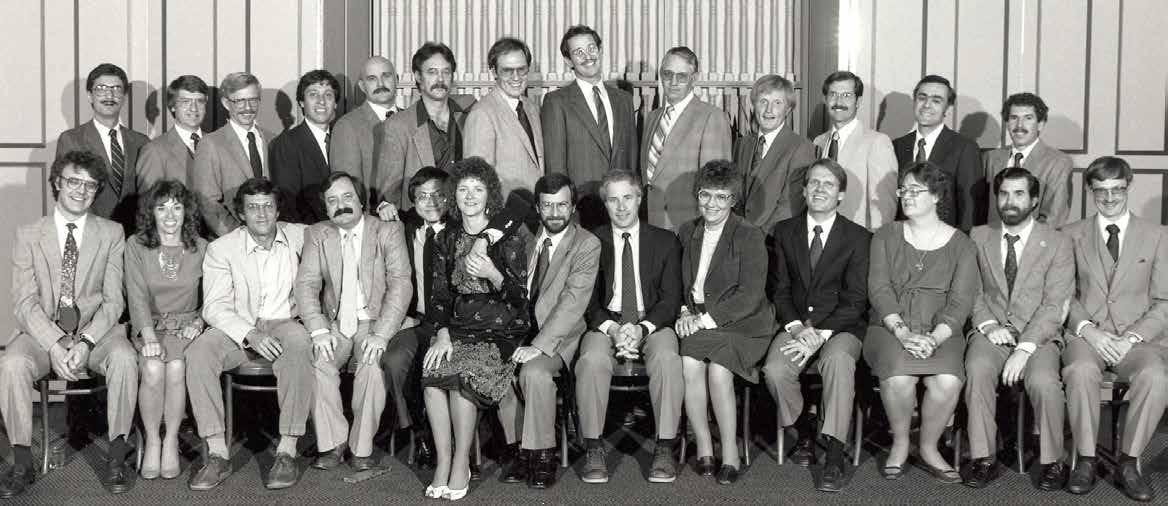
I went to UArizona Med School, class of 1974 (4th class). Biochemistry helped me immensely with my medical school courses! I did a surgical internship in San Diego and a radiology residency at UArizona. Then I took a fabulous job at Northern Arizona Radiology in Flagstaff, Arizona. Great people to work with, interesting patients, and a fascinating practice for 28 years. I retired, with regret, in 2006. Still miss the people.
Joe White PhD Chemistry,
I’m currently retired.
1967
THE CATALYST ONLINE | CBC ALUMNI MAGAZINE 22
Paul Sangster reunion photo
James Kudrna PHOTO
PhD Chemistry, 1969 (Lee B. Jones research group)
I am currently retired after a 40-year career as an orthopedic hip surgeon. I remain on the teaching faculty of the University of Chicago and previously held a professorship at Northwestern University. In retirement, I remain active by teaching residents and fellows and am active in philanthropy, supporting educational and research activities.
1970s
William Deines
PhD Chemistry, 1970 (Robert Bates research group)
I retired after 24 years in industrial research and 14 years in academia. Still happily married to Helen (57 years), living in Louisville, Kentucky. I have two daughters, one son, and four grandchildren.


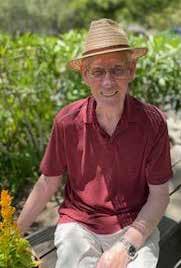

Dale Edmondson
PhD Chemistry, 1970 (Gordon Tollin research group)
I retired as a professor of biochemistry at Emory University in Atlanta, Georgia.
Gail Miller PHOTO
PhD Chemistry, 1970 Ramaley
I’m enjoying retirement, happily married, and having a good time. I have some grandchildren getting ready for higher education.
Mark Lessner BA Chemistry, 1971
I currently work as a physician and pediatrician, working full-time outpatient in Lake Havasu City, Arizona.
John Nestor PHOTO
PhD Chemistry, 1971 (John Schaefer and Henry Hall research group)
Working as CEO of EuMederis Pharmaceuticals, Inc. Consulting on the phase 2 clinical development of my latest pharmaceutical, pemvidutide; candidate for best in class for obesity and non-alcoholic steatohepatitis. Expecting this to be my 4th marketed pharmaceutical, with the prior ones marketed by Roche, Merck, and Pfizer.
Larry Schwartz PHOTO
PhD Chemistry, 1971 (Phillip Keller research group)
I run my own consulting business (IP Business-tech Solutions). I am involved with IP analysis to understand companies, technologies, strategies, etc. I am also a subject matter expert on polymer formulations, radiation crosslinking, and the business aspects of sustainability. My wife Leslie (MSRN UA, 1972) works as RN in a family clinic. My oldest daughter, Rachel, is a neuro-radiologist in LA, and my youngest daughter is a manager at a health support clinic in Santa Cruz, California.
DEPARTMENT OF CHEMISTRY AND BIOCHEMISTRY | FALL 2022
James Kudrna
Gail Miller
John Nestor
Larry Schwartz and family
Sheldon Clare PhD Chemistry, 1972 (Cornelius Steelink research group)
I’m retired after teaching at the University of Pittsburgh at Johnstown. A widower with 3 children and 5 grandchildren.
Jerry Slightom PHOTO
BS Chemistry, 1972
I am co-founder of a small biotechnology company, AureoGen Biosciences, Inc. Semi-retired and running a small farm in Illinois. Sorry that I can’t attend the 50-year reunion. I am presently living in Portage, Michigan. I graduated from Carlinville Community High School in Carlinville, Illinois in 1965 and joined the U.S. Navy. My active duty was from May 31, 1965, to September 5, 1968, during which time I received training in special weapons (nuclear weapons) first at Great Lake Naval Training Center, Great Lakes, Illinois, and then at Sandia Base, Albuquerque, New Mexico. I was stationed in the Navy Unit at Clarksville Base, Fort Campbell, Tennessee, and then stationed aboard the USS Yorktown (which is now a Naval Museum located at Patriots’ Point, Charleston, South Carolina). In 1968, I served in the Weapons Division aboard the USS Yorktown (CVS-10) as the ship was deployed off the coasts of North Korea and then North Vietnam. I heard about Eastern Arizona College (EAC) from a shipmate, Troy Megason, ’66, who highly recommended attending there when he was discharged.

With the help of the GI Bill, I attended EAC for two years and then transferred to UArizona where I graduated with a Bachelor of Science in Chemistry in 1972. After graduating, I returned to Illinois to attend Southern Illinois University in Carbondale, Illinois, and completed a Ph.D. in Biochemistry in 1975. I enjoyed research and following graduation I was involved in postdoctoral research in the laboratory of Nobel laureate Dr. Oliver Smithies, Department of Genetics, University of Wisconsin, Madison, Wisconsin. While doing research in Dr. Smithies’ laboratory, I was the first to isolate a structural plant gene (seed storage protein gene, phaseolin) and as a result, was the first to determine that plant genes contain intervening sequences (introns). In addition, I isolated some of the first human genes, including the two closely linked fetal globin genes which lead to the discovery of the fetal globin gene conversion mechanism.
In 1981, I joined one of the first plant biotechnology companies, Agrigenetics Advance Research, Madison, Wisconsin, where I was co-inventor on a patent covering the use of agrobacterium tumefaciens for the transfer of foreign genes into plants. In 1985, I was invited to join The Upjohn Company, Kalamazoo, Michigan, where I spent 18 years doing molecular biology research. While at Upjohn, I established a plant antiviral program that resulted in the development of six commercial products. Most notably, I was a co-developer of a virus resistant papaya cultivar. This invention saved the entire papaya industry in the state of Hawaii, and I was awarded (co-recipient) of the 2002 Alexander von Humboldt Award. In addition, I was a co-director of the University of Michigan DNA Sequencing Core within Dr. Francis Collins NIH Human Genome Center (1990-1994), and I was also an Adjunct Professor in the Department of Anatomy and Cell Biology, Wayne State University, Medical School, Detroit, Michigan, from 1985 to 2010.
The Upjohn Company was subjected to multiple drug company mergers, and in 2003 Dr. Ake Elhammer and I formed AureoGen Biosciences, Inc. in Kalamazoo, Michigan. AureoGen’s therapeutic focus is on antibiotics, and the company’s mission is to utilize state-of-the-art chemistry and genetic engineering methodologies to generate novel drug candidates from existing cyclic peptide templates. Many successful drugs are natural products or derivatives of natural products. In contrast to synthetic compounds, natural products are not generated by chemical synthesis
THE CATALYST ONLINE | CBC ALUMNI MAGAZINE 24
Jerry Slightom
but instead isolated from microorganisms such as bacteria and fungi. The cyclic peptides constitute an important group of natural product compounds. Drugs such as vancomycin, daptomycin, caspofungin, cyclosporin, and bleomycin all belong to this group, and their successes in the clinic demonstrate that cyclic peptides can be antibacterials and antifungals as well as immunosuppressive and even cancer drugs. As of today, my research has resulted in 181 published reviewed manuscripts as well as book chapters and 16 awarded U.S. patents and numerous foreign patents. I am a member of the Navy Nuclear Weapons Association and lifetime member of the USS Yorktown Association.
Daniel Chang PHOTO
PhD Chemistry, 1974 (Jim Mulvany research group)
I retired as a volunteer pastor for local Chinese church.

Lano Balulescu PHOTO
MS Chemistry, 1976 (Phillip Keller research group)
Well, I am still working full-time as a contracts manager for the USAF, Department of Defense. Excellent job and they’re still willing to keep me employed! Enjoy hearing from my fellow colleagues from the early 70’s.
1980s
Timothy McManamon PHOTO
BA Chemistry, 1981
I retired from Sanford Health on July 1, 2020, as PhD clinical chemist.
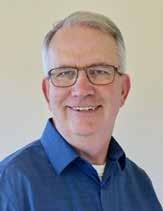
Richard Sportsman PHOTO

PhD Chemistry, 1982 (George S. Wilson research group)
I work in various roles: president and owner of Vinmetrica, a company that makes and offers wine testing equipment, reagents, and services, and owner and winemaker at Little Oaks Winery. My two websites are Vinmetrica.com and LittleOaksWinery.com.

Gregg Achatz PHOTO
BA Chemistry, 1983
I retired on March 1, 2022, after a 38-year career in the chemical industry. Now enjoying travel, gardening, teaching hot yoga, and doing a little consulting. My wife Sharon (Huish) Achatz (BA Journalism ’83, UofA) and I are retired, and are having fun cruising around Florida in our vintage VW camper-appropriately named, Wilma.
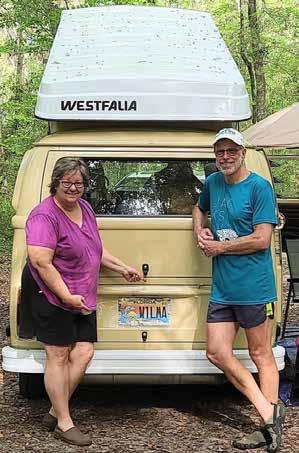
Jesse Bonfeld
BS Biochemistry, 1984
I’m currently in a business development role for R&D New Ventures group of SCHOTT North America, focusing on the government, defense, and aerospace markets. Enjoying summers on the east end of Long Island and winters in northern Virginia.
DEPARTMENT OF CHEMISTRY AND BIOCHEMISTRY | FALL 2022
Daniel Chang
Lano Balulescu
Timothy McManamon
Gregg and Sharon Achatz with Wilma
Richard Sportsman
Jose Coria
MS Chemistry, 1985 (Jeanne Pemberton research group)
I am a measurement technology manager at Hemlock Semiconductor in Hemlock, Michigan.
Mitch Denning
BS Biochemistry, 1986 (John Little research group)
I am a professor in the Department of Cancer Biology at Loyola University Chicago. My lab studies skin cancer. In July 2022, I became the associate dean for graduate education at the Health Sciences Campus at Loyola University Chicago.
Hilary Danehy PHOTO
BA Biochemistry, 1988
I am currently working as director of GxP Training for Gritstone Bio, a dynamic company developing groundbreaking immunotherapies for cancers and infectious diseases.
Gary Sims
PhD Chemistry, 1989 (Bonner Denton research group)
Dr. Sims began employment with Photometrics Ltd in Tucson in 1986 as application scientist and left as vice president and general manager of the Advanced Technologies Division. In 1993 Dr. Sims Co-founded and became president and chief technology officer of Spectral Instruments Inc. in Tucson, Arizona. He has since co-founded and acts as president of affiliated companies Rayonix in Evanston Illinois, Direct Electron in San Diego California, and Spectral Instruments Imaging in Tucson, Arizona. All four companies are involved in the design, development, and production of high-accuracy imaging sensors, detector systems, and instruments used in scientific research applications in the fields of physics, chemistry, and the life sciences.
1990s
Jani Ingram PHOTO

PhD Chemistry, 1990 (Jeanne Pemberton research group)
I am a Regents’ Professor of chemistry & biochemistry at Northern Arizona University. I was named Regents’ Professor in the fall of 2021.

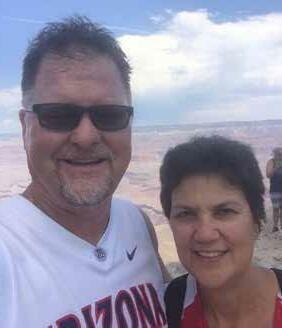
Michael Pilon PHOTO
PhD Chemistry, 1991 (Bonner Denton research group)
After earning a Ph.D. in Analytical Chemistry with the Denton Research Group in February 1991, Dr. Pilon directed the development and commercialization of the first spectroscopic elemental analysis instrumentation employing solid-state charge transfer devices for Thermo Fisher Scientific (Waltham, MA). This technology revolutionized the elemental analysis industry, and total sales of the instrumentation and related service and support products now exceeds $2 billion. With that success and the universal acceptance of the technology in the analytical instrumentation market, Dr. Pilon was promoted to general manager of Thermo Fisher Scientific’s CIDTEC Cameras & Imagers (Liverpool, NY) business. Under his leadership, the aging prod-
THE CATALYST ONLINE | CBC ALUMNI MAGAZINE 26
Hilary Danehy on a float
Jani Ingram
Michael Pilon
uct line was transformed to employ state-of-the-art imaging technology and semiconductor processes. During his 17-year tenure, the business grew 600% by supplying critical life-saving imaging technologies to radiation oncology clinics and unique scientific imaging technologies to the analytical instruments industries. In July 2020, Dr. Pilon founded Pillar Imaging (Littleton, MA), which has subsequently acquired Hampshire Controls (Dover, NH), a leading supplier of cryogenic backup systems and temperature, humidity, pressure, and air flow monitors and alarms for the biotechnology, pharmaceutical, medical, and manufacturing industries.
KC Russell
PhD Chemistry, 1992 (Victor Hruby research group) Professor and chair, Northern Kentucky University.
Michael Ruane PHOTO
BS Chemistry, 1994 (Robert Bates research group)
I work in multiple roles: Welch chair of the Department of Chemistry and Biochemistry at Texas Lutheran University, director of the First Year Experience Program, joint admissions medical program faculty director, and associate professor of organic chemistry.


Bassem Azizeh
PhD Chemistry, 1996 (Victor Hruby research group)
I joined Astellas Gene Therapies (AGT) in March of 2021 as head of quality control overseeing Analytical, Microbiology and Operations. New graduates from chemistry, biochemistry, and microbiology are free to apply for open positions at AGT. Feel free to contact me. AGT is in southern San Francisco.
2000s
Matthew Lynn PHOTO
PhD Chemistry, 2000 (Dennis Lichtenberger research group)
I was promoted to the rank of full professor in 2021, and I am now serving as the associate dean for curricular affairs at the National Technical Institute for the Deaf, one of the colleges of Rochester Institute of Technology.
Danny “DJ” Morales PHOTO
BA Biochemistry, 2000
Currently serving with the U.S. Department of Homeland Security, U.S. Air Force Reserve, and U.S. Coast Guard Auxiliary. I graduated from the U.S. Space Force’s Undergraduate Space Training School in December 2021 and am pursuing a Master’s in Public Health from Northern Arizona University.

Timothy Sikorski PHOTO
BS Chemistry, 2001
I am the G39 Chief of Information Operations for the U.S. Army V Corps in Fort Knox, KY. I recently graduated from the U.S. Army War College in Carlisle, Pennsylvania, with a master’s degree in Strategic Studies. My thesis was recognized as an outstanding thesis by the War College Foundation during the Strategic Land Power Symposium. While at the War College, I was selected for the rank of colonel, and look forward to my promotion ceremony in 2023. My post War College assignment is to Fort Knox, Kentucky, where I am serving as the chief of information operations for V Corps.

DEPARTMENT OF CHEMISTRY AND BIOCHEMISTRY | FALL 2022
Michael Ruane and family
Matthew Lynn
Danny “DJ” Morales
Timothy Sikorski
Robin Weatherhead
PhD Chemistry, 2003 (Eugene Mash research group)
Currently employed at a new job—VP of legal and intellectual property, Ventus Therapeutics.
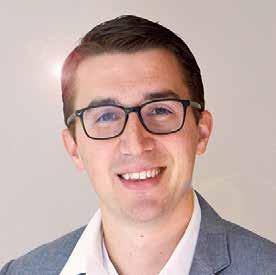
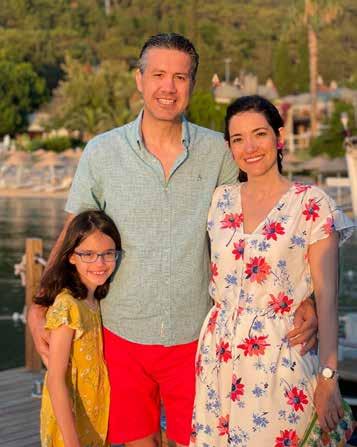
Bahar Erentok (Tan) PHOTO
BS Chemistry, 2006 (Victor Hruby research group) I graduated from University of Arizona in 2006 with a BS degree in Chemistry. I worked in Dr. Victor Hruby’s Drug Design research group which was a wonderful experience. I am always grateful for Dr. Hruby, who is an amazing professor and a wonderful person. Met my future husband at UofA, while he was working on his PhD in EE, who has been a true Wildcat getting all his three degrees from UofA. I moved back to Europe and started my career in the pharma industry, and then obtained an MS degree in Molecular Medicine in Germany. I participated in exciting research areas such as gene therapy and nuclear medicine. We moved back to the US with my family in 2013, this time to Bay Area San Francisco. I currently work as a Regulatory Affairs Manager at Corcept Therapeutics, an innovative company in the discovery and development of cortisol modulators. We are planning a trip to Tucson this fall and quite excited about it!
Tara Archuleta PHOTO

BS Biochemistry & Molecular Biophysics, 2008 (Erik Henriksen research group) Hello CBC! I grew up in Tucson and received my bachelor’s degree in Biochemistry and Molecular Biophysics from the University of Arizona. While at UArizona, I gained my first experiences in research and made lifelong connections through the CBC community. I then completed my Ph.D. and postdoctoral fellowship at Vanderbilt University, in the field of protein chemistry and X-ray crystallography. Fun fact – my roommate (and former CBCer) from UArizona, Craig Sheedy, decided to join me at Vanderbilt University for his medical school and residency training. The connection we made at UArizona allowed us to continue our friendship and become roommates again in Nashville, TN.
In 2017, I returned to the University of Arizona as a senior research specialist with the Chemistry and Biochemistry Department. Throughout my many years in research, I instructed students and research technicians in research techniques in the laboratory. After being in research for many years, I knew my calling was to teach science to others. I decided to pursue a Master of Education through the Teach Arizona Program, at UArizona, to better understand how to teach science. For the past three years, I taught chemistry and biotechnology at University High School in Tucson, Arizona. I recently received the Southern Arizona Section of the American Chemical Society High School Teacher Award for 2022. Through my work in the public school system, I have been able to help share my passion for science and scientific research with my students. Over the past few years, many of my students have been able to participate in various internship programs at UArizona (KEYS, Steps 2 STEM, STAR Lab, and SaferFoodCats). This Fall 2022, I am excited to continue and expand my journey as an educator with the CBC teaching faculty.
Michael Ferracane PHOTO
BS Chemistry, 2008 (Robin Polt research group)
Michael graduated with a BS in BMB and chemistry in 2008, and he conducted research with Dr. Robin Polt while at UArizona. Michael then went on to earn his PhD in Organic Chemistry at the University of Virginia. He is now a faculty member in the Chemistry Department at University of Redlands, a small liberal arts college in the Los Angeles area. His research uses computational, synthetic, and spectro-
THE CATALYST ONLINE | CBC ALUMNI MAGAZINE 28
Bahar Erentok (Tan) and family
Tara Archuleta
Michael Ferracane
scopic methods to investigate the structure and behavior of peptides and the enzymes that degrade them. The goal of this work is to better understand the properties, activity, and therapeutic potential of these species. Michael was recently promoted to associate professor with tenure, and he was awarded $250 thousand from the National Science Foundation to support ongoing research. While at UArizona, he also met his wife, Victoria Nguyen, BMB in the class of 2007, who earned her PharmD from Midwestern University and is currently working as a pharmacy manager at CVS.
Tori (Lani) Hidalgo PHOTO
PhD
Chemistry, 2009 (Dennis Lichtenberger research group)
I am an Assistant Professor of Practice at the University of Arizona in the Chemistry and Biochemistry Department. I have won of the Distinguished Early Career in Teaching Award, The Innovation in Teaching Award, and University of Arizona Foundation Leicester and Kathryn Sherrill Creative Teaching Award. I was also a top-five finalist for the Five Star Faculty award. Most of all, I have two beautiful daughters.
Craig Sheedy PHOTOs
BS Biochemistry; BS Physiology, 2009 (Megan McEvoy research group)
Go Cats! My name is Craig Sheedy; I was a student at the UofA from 2004-2009, graduating with majors in Biochemistry and Physiology. My experience at UArizona was amazing! I appreciate and will always be thankful for the outstanding educators and mentors in CBC. I was active in the department and Biochemistry club, while working in research with Dr. Megan McEvoy performing protein crystallization. As a student-athlete, I was a member of the 2008 National Champion Swimming and Diving teams and received the Walter Byers postgraduate scholarship from the NCAA. Since graduation I completed medical school then emergency medicine residency training, both at Vanderbilt in Nashville, TN. I have to give a special shout-out to Tara Archuleta, also a CBC alumnus, who recruited me to Vanderbilt and completed her Ph.D. at the same time :). Since finishing residency in 2016, I moved to Arkansas with my partner Drew, where I work for SCP Health and serve as the assistant medical director at Northwest Medical Center in Bentonville. I love my career- there is never a dull moment in the emergency department, as we see everything from heart attacks, strokes, and trauma, up to and including a novel virus pandemic. I also work with 3rd and 4th year medical students, trying my best to pass on the outstanding education that I have received, and was voted Preceptor of the Year in 2019. Additional Fun Fact: One of my research pictures was used by the UA on a billboard.


2010s
Mary-Helen Wanat
BS Biochemistry, 2011 (William Montfort research group)
I work as an epidemiologist for the CDC’s Overdose Data to Action grant within the Maricopa County Department of Public Health in Phoenix. I lead a new team conducting non-fatal overdose and hepatitis C virus investigations to better characterize the opioid overdose and hepatitis C syndemic as well as to connect people to care.
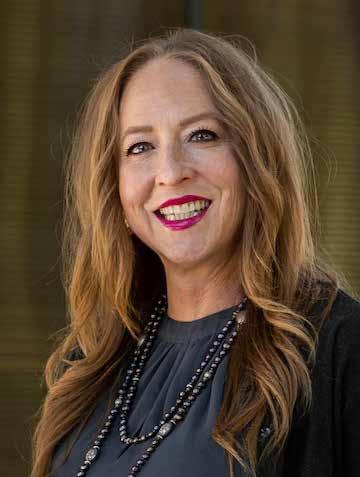
Elyssia Gallagher PHOTO
PhD Chemistry, 2013 (Craig Aspinwall research group); BS Chemistry, BS MCB, 2007 Dr. Elyssia S. Gallagher, CBC Alumna, Class of 2007 and 2013. has been named the 2022 recipient of the Ron Hites award given by the American Society of Mass Spectrometry. Dr. Gallagher was recently promoted to Associate Professor with tenure in the Department of Chemistry and Biochemistry at Baylor University. She earned a BS in Chemistry and Molecular and Cellular Biology at the University of Arizona in 2007,
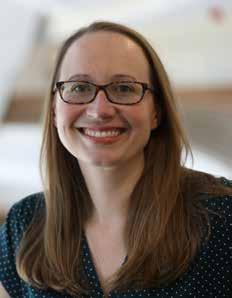
29 DEPARTMENT OF CHEMISTRY AND BIOCHEMISTRY | FALL 2022
Tori (Lani) Hidalgo
Craig Sheedy featured on a UA billboard
Craig Sheedy on 2008 National Champion Diving team
Elyssia Gallagher
graduating summa cum laude and Phi Beta Kappa. In 2013, she received her Ph.D. in Chemistry from the University of Arizona under the direction of Dr. Craig Aspinwall. She was then awarded a National Research Council Postdoctoral Research Fellowship in the Biomolecular Measurement Division at the National Institute of Standards and Technology (2013–2015, advisor: Dr. Jeffrey Hudgens). Since starting at Baylor she has received an NSF CAREER award and is also funded by The Welch Foundation. The long-term goal of the Gallagher group is to advance the field of glycobiology through the development of novel analytical approaches that define glycan structures and their roles in diverse cellular processes. Dr. Gallagher’s current research efforts focus on the development and application of novel methods to characterize glycans, glycoproteins, and their biologically relevant interactions.
Daniel Dokuchitz PHOTO
BS Chemistry, 2013 (Andrei Sanov research group)
I am currently a lab manager at Linde Electronic Gases & Specialty Products in Durham, North Carolina. I recently accepted a promotion to lab manager at Linde. I was previously a product development chemist for four years with the company.


Amanda Roberts PHOTO
MA Chemistry, 2013
I am an assistant professor of chemistry at the University of the Incarnate Word (UIW) and Co-PI of Girls in Engineering Mathematics and Science (GEMS) at UIW ’s Autonomous Vehicle Systems (AVS) Research Lab. I earned my PhD in Biomedical Sciences from the University of North Texas Health Science Center at Fort Worth and earned a Venture Finance Certification from UC Berkeley School of Law VC University Program.
Spencer Carey PHOTO
BS Chemistry, 2013 (Stephen Kukolich research group)
Hello everyone! My name is Spencer Carey, and I graduated with a BS in Chemistry and a mathematics minor in 2013. I am most grateful to UArizona, especially its research opportunities for undergraduates. I spent three years working with Dr. Stephen Kukolich using microwave spectroscopy to study molecular structures. This work opened many doors for me and prepared me well for graduate school.
I went on to earn my PhD in Analytical Chemistry from the University of Washington. My dissertation focused on the thermodynamics of adsorbates on catalyst surfaces, which allowed us to understand how catalysts speed up reactions and why some work better than others. In 2018, I graduated from the University of Washington, got married, and moved to Germany (all in three months)! I worked as a postdoctoral researcher at the Fritz Haber Institute in Berlin for three years, where I spent more time analyzing catalysts. I spent much time at the Institute’s synchrotron facility using x-rays to probe surface reactions and catalyst chemical structures.
While in Germany, my wife and I traveled all over Europe, North Africa, and the Middle East. Today, I work as an analytical research scientist for Chevron Phillips Chemical Company in Houston. Much of my time is spent assisting our catalyst research groups and analyzing various mystery samples from our production facilities that are causing problems, but I am particularly excited about our research in chemical recycling. The processes that we are working to perfect allow us to convert waste plastic polymers back into its building blocks, which are then used to create new chemicals or circular polymers.

THE CATALYST ONLINE | CBC ALUMNI MAGAZINE 30
Daniel Dokuchitz
Amanda Roberts
Spencer
Carey
Amy Glynn PHOTO
BS Chemistry, 2014
After completing an enlistment with the U.S. Coast Guard in the spring of 2012, I started my undergraduate degree in chemistry at the UA in the fall of 2012 and graduated in winter 2014. My son was born in 2015; and that same year, I began working for the Food and Drug Administration as an Investigator in the San Francisco Bay area. In addition to staying in touch with some of my amazing UA graduating alumni friends, my family and I moved to Washington state in 2016; and I obtained a Masters of Public Health from the University of Washington in 2018. I had a little girl in 2019, and continue to work for the FDA, currently as a compliance officer in the Seattle area. Although I no longer do direct research, I continue to use the knowledge I gained while in school on a day-to-day basis, specifically regarding instrumentation and analytical methods. I often think back on my time at the UA, and words cannot express how much I appreciate all the help and support I received from the faculty and staff within the school, and specifically within the Department of Chemistry and Biochemistry, as well as the Veterans Affairs Office and Medical Center!

Cheryl Cheah PHOTO
BS Biochemistry,
2015 (Michael Daines research group)

Hi everyone! I’m a current pediatrics resident at UCSF. As 2022 comes to a close, I look back on the year with much fondness and gratitude. This was the year that brought me out of my comfort zone, but one that led to the most growth. Residency has been a roller coaster ride with many physical and emotional ups and downs. I treasure the moments of introducing new parents to their babies, watching reels in the dark with my spunky teenage patients, but also carry with me the rare, somber moments that occur when limitations of medicine are reached. I moved to San Francisco 2.5 years ago at the height of the COVID pandemic with few expectations and connections. Now, I have a community that inspires and lifts me up daily, and it sure takes a village! 2022 has been a memorable one, but it has primed 2023 to be pretty incredible! Looking ahead, I’m thrilled to be staying at UCSF for a neonatal-perinatal medicine fellowship, and continue working to reduce morbidity and mortality in neonates who suffer hypoxic-ischemic brain injuries. 2023 will also be the year that I’ll be marrying my best friend Shane, who has been in the front row unconditionally laughing and screaming with me through it all!
Shaina Hasan PHOTO
BS Biochemistry; BS MCB, 2015 (Frans Tax research group)
After graduating from U of A, I worked as a postbaccalaureate intern at the National Institutes of Health in Bethesda, Maryland, studying the mechanism of transcription termination in S pombe yeast. From there, I attended medical school at Mayo Clinic Alix School of Medicine in Scottsdale, Arizona — as part of the inaugural class — where I became involved in more translational research related to optimizing diagnosis of pediatric eosinophilic gastrointestinal disorders. I am currently an internal medicine resident at the University of Virginia in Charlottesville, Virginia, with the goal of applying to a fellowship in gastroenterology.
Kevin Jung PHOTO
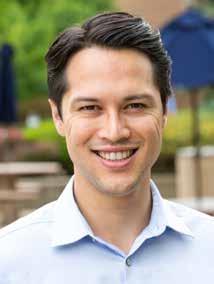
BS Biochemistry, 2015 (Eli Chapman research group)
I graduated in 2015 with a BS in Biochemistry and moved out to Chicago afterwards. Have worked in pharmaceutical manufacturing, clinical testing, technical writing, and covid testing. Currently working in quality assurance for a medical device company.
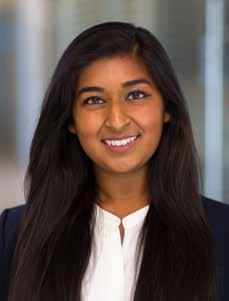
31 DEPARTMENT OF CHEMISTRY AND BIOCHEMISTRY | FALL 2022
Amy Glynn with husband Pete, son Addison (7) and daughter Ophelia (2)
Cheryl Cheah with fiance Shane
Shaina Hasan
Kevin Jung
Taylor Szyszka PHOTO
BS Biochemistry, 2015 (Matthew Cordes research group)
I was a biochemistry major who graduated in May of 2015. I absolutely loved my experience at the U of A! As an out of state student, I fell in love with Tucson and life in the desert, and I thrived in the tight-knit community of CBC. I was heavily involved in the Chemistry Club and served as president my senior year. It was this experience that most enriched my university years; I made incredible friends, was surrounded by passionate people, and through these relationships I became involved in undergraduate research which paved the way for my career now. I spent three years in the protein evolution lab of A/Prof. Matthew Cordes working closely with Dr. Vlad Kumirov, where I discovered my passion for protein NMR and structural biology. After graduation, I was awarded an international student scholarship for my PhD studies under Prof. Joel Mackay at The University of Sydney in Australia. During my PhD, I used NMR to elucidate the structure of a transcription factor protein domain binding to a small peptide and did preliminary drug discovery work to develop a small molecule inhibitor to block this interaction, which could potentially be of therapeutic value.
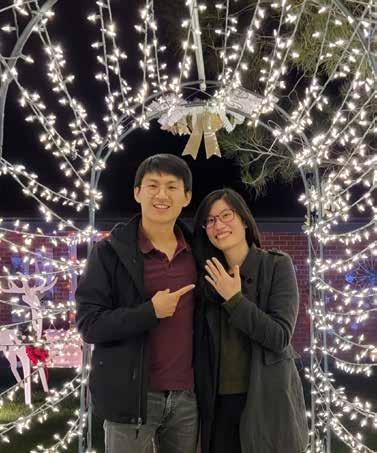
Inspired by my time in the Chemistry Club, I also became an avid science communicator while working closely with school students and the public, and even appeared in a few seasons of a children’s science TV show called “Get Clever!” After my PhD, I spent a few years pursuing science communication at the high school and university level before starting my current role as a postdoctoral research associate at The University of Sydney. I now work in the lab of Dr. Yu Heng Lau, where I use my protein knowledge to engineer protein nanocompartments to enhance the activity of important enzymes to improve the way photosynthetic organisms convert CO2 into sugar.
Very excitingly, I have just been selected as one of Science and Technology Australia’s Superstars of STEM! Over the next two years I will receive advanced media training to raise my public profile as a female scientist and speak about my research in the media as well as share my story with school students to inspire a new generation of young scientists. I am very proud of what I have accomplished so far, and I know that my time in CBC gave me the skills and confidence to move to a new country and embark on an academic career. I couldn’t imagine a better place to start my scientific training!
Christopher Chan PHOTO
BS Biochemistry; BS MCB; BS Neuroscience & Cognitive Science, 2016 (Victor Hruby research group)
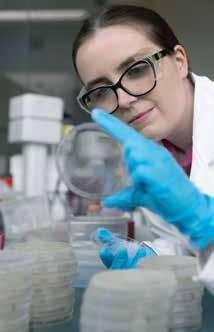
After I graduated in 2016, I joined Bachem Americas, Inc., as a production chemist in Torrance, CA, applying my peptide synthesis knowledge from Dr. Hruby’s lab. Realizing I missed academic research, in 2019 I joined the Department of Cardiology at UCLA as interim lab manager, studying cardiac arrhythmias in the porcine model. After three years in cardiology, I moved on to the Department of Neurosurgery at UCLA to facilitate clinical research in human memory and epilepsy. Lastly, I proposed to my now-fiancée at Winterhaven and am happily engaged!
Denisse Divine PHOTO
BS Biochemistry, 2016 (Monica Schmidt research group)
I just recently moved to Carlsbad, California in September of 2022 after being promoted to supervisor for GenMark Diagnostics (a member of Roche Group). As a supervisor, I am supervising/managing around 40 people in the ePlex Manufacturing Department. The ePlex system is a wonderful device that helps when it comes to diagnosing various kinds of illnesses such as respiratory, fungal, bacterial, gastrointestinal, etc. I’ve been learning a lot of things both on the technical aspect and leadership aspect of our business. It has been a wonderful transition so far. The people I work with are knowledgeable, enthusiastic, and really love what they do. During my

THE CATALYST ONLINE | CBC ALUMNI MAGAZINE 32
Taylor Szyszka
Christopher Chan and fiancée
Denisse Divine at the Miramare Castle in Trieste, Italy
free time, I enjoy walking along the beach, drinking coffee, and reading books. I also like traveling, taking pictures, and going to various museums.
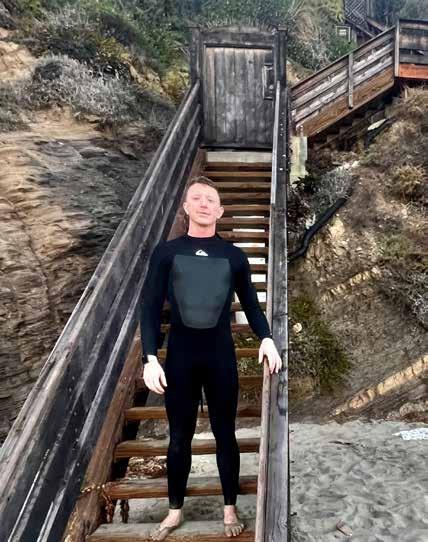
Courtney Moore
BS Biochemistry, 2016 (Ronald Lynch research group)
I graduated in December with a PhD in Chemistry from the Georgia Institute of Technology. Now, I have moved to the Bay Area and am working as a product development scientist for The Clorox Company.
Nathan Napierski PHOTO
BS Biochemistry; BS MCB, 2016 (Samantha Harris research group)
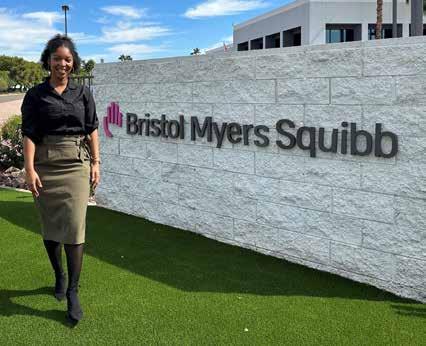
Nathan enjoys bringing light and energy into the room when he arrives. This was evident in his appearance on the famous show The Price is Right where he did back flips and joked with Drew Carey as he won a motorcycle, washer and dryer, and a TV! Nathan is an alumni of CBC and graduated from the University of Arizona in 2016 with a B.S. in both biochemistry and molecular cellular biology. Since graduation, he’s bartended, conducted cardiovascular disease research, published first author articles in high impact journals, and taught chemistry for our famous Dr. Tori Hidalgo as a TA. A few years after graduation, Nathan moved to sunny Southern California and entered the medical device field as an engineer. He works at Masimo, a noninvasive medical device company and works on life saving equipment such as pulse oximeters and opioid withdrawal reducers. In addition to engineering, Nathan’s passion for fitness and wanting to help others guided him to become a certified personal trainer and nutrition coach. With that, he trains high-end cliental at a well-known luxurious gym called Equinox. Nathan recently came back to the University of Arizona for 2022 Homecoming to cheer on the field as he once did back in college for our Wildcats! Over the next few years, Nathan wants to find a partner, have kids, buy a home, and one day hopes to bring his family to see the University of Arizona too!
Kassidy Tompkins
BS Biochemistry, 2016 (Nancy Horton research group)
I am a scientist at Roche Tissue Diagnostics. My second son was born in March of 2021. Graduated with my PhD in January of 2021.
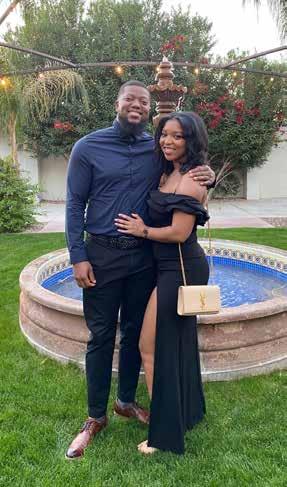
Taya Adams-Mathis PHOTOs BS Chemistry, 2017
It has been 5 years since graduation, and every time Olivia would send me the request to add my story in the alumni magazine, I would hesitate. Thinking that maybe next year when I am doing some amazing things at work I will send in a story, or maybe when I get a promotion I will send in my story. I always was worried that I wasn’t doing enough, but this year I decided that we are all on our own paths and journeys, and mine is just as important as many of my other classmates.
Right after graduation I started working as a lab technician at Insys Therapeutics, and after a year of being a lab technician, I was promoted to Analytical Scientist, where I performed routine testing on our drug products. After a year I moved on and started a contract position at Celgene where I input master data so that all the required routine testing that was being performed by the laboratories could have an electronic repository instead of paper documentation. Since this role was a contracted position, I decided that I would like to work full time for Celgene, and I was fortunate enough to get hired on as a Specialist in Quality Assurance. This role took me out of the lab and instead let me see a different side of the pharmaceutical industry. I began reviewing, approving, and ensuring that all the data from the labs were compliant with all regulatory agencies. I was in this role for 3 years, and I felt like I got to learn so
33 DEPARTMENT OF CHEMISTRY AND BIOCHEMISTRY | FALL 2022
Nathan Napierski
Taya Adams-Mathis and husband
much! I recently got the opportunity to begin working as a manager in the Business Operations department for Bristol Myers Squibb (Celgene was acquired by Bristol Myers Squibb in 2019), and in the short month that I have had the chance to work in Business Operations, I feel like I have continued to evolve and grow my skills in the pharmaceutical industry. In business operations, I have already had the opportunity to create a business continuity plan, which evaluates the risks to the business if we are not able to produce product and think of ways we can strategically ensure that all our markets are getting the medication that is needed for our patients.
I honestly don’t know where I am going, but I want to continue to grow and develop my skills so I can continue doing things that I love and work in the pharmaceutical industry, where I know the medications that we are producing can help save lives.
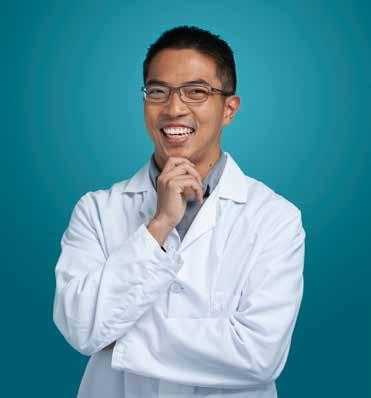
Kyle Lopez PHOTO
BS Biochemistry; BS MCB, 2017 (William Montfort research group)
After my BS in Biochemistry and Molecular & Cellular Biology at the University of Arizona (class of 2017), I continued my work in Dr. Bill Montfort’s lab at UArizona over the summer following my senior year. This work entailed using luminescent probes to measure intramolecular protein distances and changes upon ligand binding. Afterwards, I began work on my PhD in Biophysics at the University of California, San Francisco (UCSF). I did my dissertation work in Dr. Daniel Southworth’s lab where I worked on cryoelectron microscopy (cryoEM) studies of bacterial ATPase-protease complexes. During graduate school, I determined the first high resolution structures of the E. coli ClpAP system and determined the activation mechanism of a potential antibiotic targeting this system in M. tuberculosis. I received my PhD in June of 2022 and began a postdoctoral position at Arizona State University (ASU) in Dr. Wade Van Horn’s group, where I use cryoEM and other biophysical approaches to determine the molecular mechanisms of heat sensation in TRP family proteins. I recently deferred an ASU presidential fellow position for a year, which is a program that allows for a more independent postdoctoral career with the intention of providing a tenure track faculty position after 2-4 years at ASU. I’m excited at the opportunity to run my own research group and keep an eye out for the Lopez lab coming sometime between 2025-2027. I appreciate the opportunities provided by the Chemistry and Biochemistry department during my time at the U of A that contributed to my success in science.
Isen Calderon PHOTO PhD Chemistry, 2018 (Craig Aspinwall research group)

I just exited my first industry job at Rubius Therapeutics, worked as a Formulations and Drug Product Engineer for a little over a year. I will be starting a new position at BlueRock Therapeutics in Boston MA as a Process Development Scientist focusing on Drug Product and Stability. In my spare time I love to play volleyball and bake.
Anthony Raviele
BS Biochemistry, 2018 (Aikseng Ooi research group)
After graduating with a B.S. in Biochemistry, I completed a degree in Pharmacy (PharmD) also at the U of A. Shortly after this, I pursued post-doctorate fellowship in Clinical Pharmacology at Indiana University School of Medicine (IUSM). Upon finishing that program, I took a position with Bristol-Myers Squibb as a Research Investigator conducting pharmacokinetic and pharmacometric analyses in human clinical trials. This has taken me step by step from the West Coast all the way over to the East Coast. Now residing in the NYC metropolitan area, I’ve been enjoying the city life and experiencing true seasons while also making the most of time off whenever available to travel.
THE CATALYST ONLINE | CBC ALUMNI MAGAZINE 34
Kyle Lopez
Isen Calderon
Dane Zambrano PHOTO
BS Biochemistry; BS MCB, 2018 (Michael Marty research group)

After leaving the UArizona, I joined Neil King’s lab at the University of Washington’s Institute of Protein Design as a graduate student, and now as a PhD candidate. My lab works on developing protein nanoparticle vaccines to target diseases like influenza, RSV, and the novel coronavirus SARS-CoV2. My main goal in the lab is to design hybrid two-component nanoparticles that interface proteins as well as lipids as a new platform for targeted vaccine or drug delivery. I accomplish this by computationally designing proteins using Rosetta and AlphaFold software and docking those proteins into a specific nanocage geometry in silico. After filtering thousands of designs, some can be ordered and validated using techniques like native-Mass spec, negative stain, and cryo-electron microscopy. I’ve been very fortunate to have mentors like Michael Marty (UA) and Neil King (UW), who have always fostered my curiosity for science and who aren’t afraid to try crazy ideas!
Metin Karayilan PHOTO
PhD Chemistry, 2019 (Jeffrey Pyun research group)
I recently started as an assistant professor of chemistry at Case Western Reserve University (CWRU) in Cleveland, Ohio. I am looking forward to seeing the applications from the University of Arizona for CWRU graduate programs, especially chemistry and macromolecular science and engineering. I was also recently selected as an ACS Lasting Encounters between Aspiring and Distinguished Scientists (LEADS) fellow and attended the ACS LEADS Conference in DC. I met highly esteemed chemists, scientists, professionals, future leaders, and Nobel laureates.
Emma Harrell
BS Biochemistry; BS MCB, 2019 (Jacob Schwartz research group)

After graduating from the UA with my Bachelor’s in Biochemistry/MCB in 2019, I successfully completed a Master’s in Biomedical Sciences at UTSW Medical Center in Dallas, TX. I’m now working as a research professional in the Lab for Fetal and Regenerative Biology (LFRB) in the Department of Surgery at the UA. I plan to return to school to complete a PhD in biophysics or structural biology.
Hunter Pitts
BS Chemistry, 2019
I am working for Sherwin-Williams doing chemistry R&D. I got my Master’s Degree in Materials Science and Engineering from the University of Texas at Arlington in December of 2021.
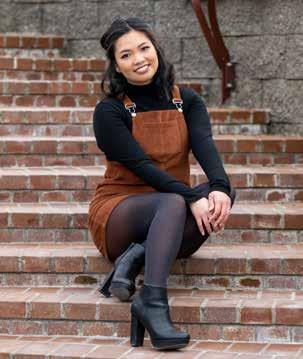
Heber Lara PHOTO
BS Biochemistry; BS MCB, 2019 (William Montfort research group)
Heber is currently a PhD candidate at the University of Washington in the Department of Immunology. He is interested in understanding how our bodies respond to pathogens and subsequently recover from infections. Specifically, Heber is examining how the cellular composition of the small intestine changes during a parasitic worm infection, and how that remodeling influences tissue regeneration. As an underrepresented minority (URM) scientist, Heber is involved in outreach programs that encourage other URM students to pursue STEM careers. He has mentored prospective graduate students and has acted as a graphic designer for URM focused initiatives like Cientifico Latino. After graduating, Heber hopes to join a biotechnology group and continue outreach to URM students.
35 DEPARTMENT OF CHEMISTRY AND BIOCHEMISTRY | FALL 2022
Dane Zambrano
Metin Karayilan with Dr. David MacMillan, a 2021 Chemistry Nobel laureate
Heber Lara
Tyler Roberts PHOTO
BS Chemistry; BS Biochemistry; BS MCB, 2019; MS Chemistry, 2020 (Jeanne Pemberton research group)
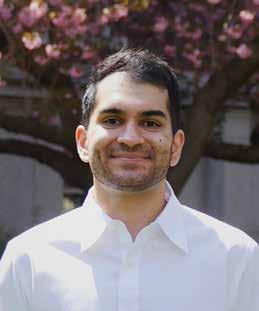
Tyler Roberts has spent the last year in central Japan teaching English. He participated in a Ministry of Culture sponsored program called Japan Exchange and Teaching Programme or JET for short. The program’s aim is to promote both English education and internationalization by providing both Japanese students and participants from English speaking countries the opportunity to learn from other cultures directly. Tyler taught Japanese students from the ages of 12-18 in junior and senior high school and took advantage of his science background to teach students presentation and research skills. He also conducted never-before-done science lessons exclusively in English. While there, he had the opportunity to visit 10 of the 47 prefectures and saw incredible cultural sights and locations of immense natural beauty. “I skied Japow in Nagano, saw the stunning historic sites in Kyoto, and explored the old-growth cedar forests of faraway Yakushima off the coast of Southern Japan, to name a few.” Tyler said that the experience was the most unique and eye-opening of his life, and that he will carry the lessons learned about culture, perspective, and resilience with him always. He is still excited about his return to CBC this fall as a full-time organic lab TA, and hopes to continually improve his ability to educate and engage students. “I’ve been looking forward to teaching chemistry again as well as seeing old friends and new and catching up! Thank you for having me, I am grateful.”
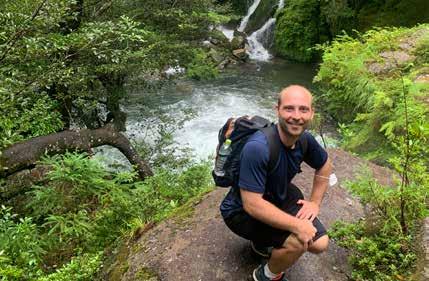
Nathan Rundhaug PHOTO
BS Chemistry, 2019 (Oliver Monti research group)
I worked as a chemist and decided to go back to school to obtain my JD at the UArizona as a TechLaw fellow. I am currently working in health and compliance law and am excited to see where I go next! I’m doing great at my internship, and we’ll see if it continues past my graduation next May. I’m also got engaged this August!
Satya Acharya PHOTO
BS Biochemistry, 2020 (Steven Goldman research group)
After graduating from the University of Arizona in 2020, I attended the Columbia University Mailman School of Public Health where I earned a Master of Public Health in Health Policy. Currently, I live in Manhattan and work in healthcare as a consultant at CBIZ Optumas. Some of my favorite things to do in New York are running in Central Park and getting dinner at Malatesta Trattoria, which has the best pasta in the city!
Ahmad Luqman Afiq Abdullah PHOTO
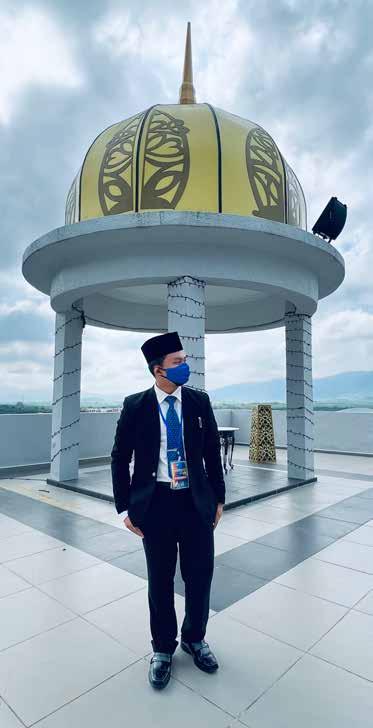
BS Chemistry, 2020
I’m currently working as a science officer at Universiti Malaysia Perlis (UniMAP), Malaysia. I was awarded Best Male Participant for the Program Transformasi Minda, PTM (Translation: Mind Transformation Program), a program that all new government staff are required to attend. It’s like an orientation or an introductory program which is held for 5 days, from 9 am to 4:30 pm. During the orientation, new staff listen to many speakers from UniMAP who give presentations that introduce the university, the law, the government, ethics, etc. New staff also participate in group discussions which involve presentations. On the fifth day, there’s an exam to test our understanding of the program.
Jessy Forelli PHOTO
BA Biochemistry; BS MCB; BA Spanish, 2020 (Ronald Lynch research group)
I was raised in New Jersey, but once I stepped onto the UA campus, I knew I was home. My family had visited the area several times since my great grandparents were snowbirds. I went back during high school to visit for a tour which reminded me how
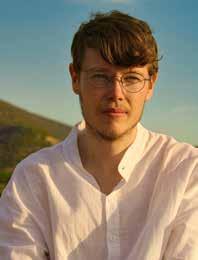
THE CATALYST ONLINE | CBC ALUMNI MAGAZINE
Tyler Roberts
Nathan Rundhaug
Satya Acharya
Afiq Abdullah
Ahmad Luqman
much I loved the area. After I was accepted, I enrolled as a biochemistry major since I loved STEM classes and desired to do research.
After adjusting to college life, I wanted to take advantage of all the university had to offer. With so many campus events happening, I wanted to join more things than I could count. I was a resident assistant in the Honors College, competitive cheerleader, student researcher at OSIRIS-Rex, Arizona ambassador, after-school STEM club facilitator, and a member of several other on-campus clubs. I also added majors in Molecular and Cellular Biology and Spanish to complement my CBC courses.
I became deeply passionate about translating my studies into community outreach. Wanting to explore this more professionally, I began as an AmeriCorps volunteer with the International Rescue Committee (IRC) in Tucson. I served as a case assistant in the Survivors of Torture program, where I supported refugees and asylum-seekers in the area to reach self-sufficiency. My research seminars prepared me well for this position, as a core aspect of those courses was digesting complex concepts into key points understood by the public. I often did this for clients after they received jargony responses from doctors and lawyers.
After graduating summa cum laude in May 2020, I began working full-time with the IRC. I dedicated much of my time ensuring clients were safe and healthy during the COVID pandemic, and now I work in IRC HQ assisting our nationwide Unaccompanied Children programming. Personally, I am preparing for my wedding in July 2023. I will begin a Master’s in International Education in the fall. My time with UA and CBC inspired me to take this next step. Bear down, go cats, and go CBC!
Steven Fried PHOTO
BS Biochemistry; BS Chemistry; BS Math, 2020 (Michael Brown research group)
I just entered my third year in a chemistry PhD program at Stanford University, where my concentration is in biophysical chemistry. I am working in Professor Steven Boxer’s lab, where I am researching the electrostatic basis of enzyme catalysis, and ways to experimentally measure electric fields in enzyme active sites and other heterogeneous environments. I am grateful to be enjoying the people, climate, scenery, and opportunities to explore Northern California while I am here.

Jibriel Noun PHOTO
BA Chemistry; BA Biochemistry; BS MCB, 2020 (Ronald Heimark research group)
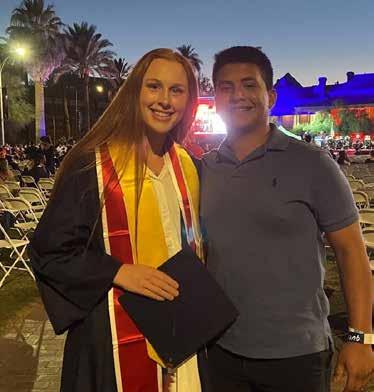
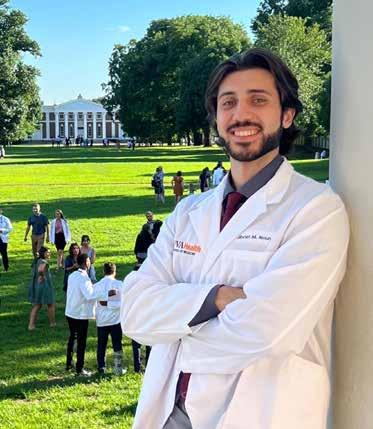
The past year I have received the Cancer Research Training Award and have been working as a clinical research assistant at the National Cancer Institute in the Urologic Oncology Branch under Dr. Peter Pinto, head of the Prostate Cancer Section. I started this Fall at the University of Virginia School of Medicine to be a part of the class of 2026! I wouldn’t have been able to get this far without my incredible experiences at the University of Arizona.
Tommy Szeto PHOTO
BS Biochemistry, 2020 (Jun Wang research group)
After graduating from the University of Arizona Department of Biochemistry and Chemistry in 2020, I had the opportunity to apply my skills and knowledge by conducting research in the field of biochemistry, pharmacology, and proteomic virology. Starting in May of 2020, I was a laboratory technician with the Jun Wang Lab at the University of Arizona Department of Pharmacology and Toxicology, working alongside other scientists to better study various diseases such as influenza, enteroviruses, and COVID-19. Our efforts were aimed at developing antivirals that targeted these emerging viruses by utilizing techniques of structure-based drug design, high-throughput screening, and peptide chemistry leading to X-ray crystallographic
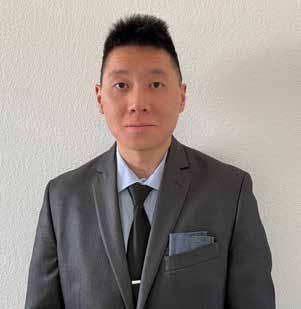
37 DEPARTMENT OF CHEMISTRY AND BIOCHEMISTRY | FALL 2022
Jessy Forelli
Steven Fried
Jibriel Noun
Tommy Szeto
structural work. This field of pre-clinical drug discovery and research starting from molecular-level design has led me to the field of phlebotomy.
I have since moved into the clinical setting as a phlebotomist. I work alongside a dedicated and caring community of medical professionals to provide healthcare utilizing my skills in the field of biochemistry. As a phlebotomist, I am tasked to collect blood samples from patients to perform biochemical analysis. By testing these blood samples, the healthcare team may examine the patient’s blood for toxicology- analysis of drugs and poisons, immunochemistry to detect and measure hormonal and enzymatic substances, and serology to identify microorganisms for antibiotic therapy. One day, I hope to return to the University of Arizona to attend medical school in order to become a physician.
Yasir Alnakhli PHOTO
BA Biochemistry; BS Chemistry, 2021
I work as a cleanroom operation technician at the Nanofabrication Core Lab in King Abdullah University of Science and Technology (KAUST) where we provide expertise in the fabrication and characterization of the nano and micro-scale devices to the research community of KAUST and our other partners from academics and industrial organizations. My role here extends across three main areas that are facility operation, processes development, and providing training for end-users.
Armando Cardenas PHOTO


BS Biochemistry, 2021 (Michael Hammer research group)
After graduation, I moved out to St. Louis, Missouri, to work at Pfizer. I currently work within the Biotherapeutics Pharmaceutical Sciences, Pharmaceutical Research and Development group. Our group is responsible for developing drug product formulations and processes for our large molecule projects, including vaccines and gene therapies. Some of my current research within the group is focused on lyophilization of drug products and the research and development of mRNA lipid nanoparticles. Outside of work, I enjoy playing sports and hanging out with friends. I also recently got a dog (pictured), her name is Nala, and she loves to get in trouble! Although I do miss all my friends and family in Tucson, I am enjoying living in a new city and meeting new people and very grateful to have this opportunity to work with such a great team at Pfizer.
Christina Huynh PHOTO
BA Biochemistry; BS Nutritional Sciences, 2021 (Ashley Linares-Gaffer research group)

I am currently pursuing my accelerated master’s in Clinical Nutrition at the University of the Pacific. This program emphasizes comprehensive clinical nutrition care and upon graduation, I will become a registered dietitian.

Monica Ruffalo PHOTO
BS Biochemistry, 2021 (Jacob Schwartz research group)
My name is Monica Ruffalo, and I graduated cum laude with a BS in Biochemistry in 2021. I am currently a graduate student in the College of Education and will graduate in 2023 with a MA in Special Education and the coursework necessary to get my Board Certification in Behavioral Analysis (BCBA). I currently work with a company providing in-home pediatric behavioral health services to get my supervision hours needed as well. Previously, I was an intern with Banner Pediatric Health. I plan on working as a BCBA after graduation, with a long-term goal of creating independent living homes for adults with special needs that include businesses (such as car washes and bakeries) that the adults can work at if they choose.
THE CATALYST ONLINE | CBC ALUMNI MAGAZINE
Yasir Alnakhli
Armando Cardenas
Christina Huynh
Monica Ruffalo and family
Keeper Sharkey
PhD Chemistry, 2015; BS Chemistry; BS Math, 2010
Dr. Keeper Sharkey, a CBC research associate and founder of ODE, L3C, was recently highlighted in the “40 Under 40 in Cybersecurity” special edition of Top Cyber News Magazine

The special edition spotlights remarkable cybersecurity and digital industry professionals. Dr. Sharkey’s research involves theorizing using “Quantum Chemistry for Detecting Cyber Security Threats on Information Systems,” which is also the name of the paper that led to Dr. Sharkey’s designation as a panelist at the Department of the Air Force Information Technology Conference (DAFITC) in August of 2022.
In the paper, Dr. Sharkey writes, “Potentially breakthrough progress is being made in the realm of explicitly correlated particles using next generation scaling algorithms. This work has the potential to redefine the battlefield by relating PKI directly in chemical states. Highly accurate descriptions of vibrations and heat motion of atoms/ions, molecules as qubits or qudits that are caused by electric and magnetic fields are necessary to find and isolate security threats in information systems. Currently accepted by the broader scientific community, the Born-Oppenheimer-type Hamiltonians (BOH) used to describe physical properties of chemical systems neglect the mass polarization interactions and explicit particle correlations that need to describe vibrations and heat motions in the excited states of [qubits/]qudits used for quantum information processing.”
Dr. Sharkey was published 6 times as an undergraduate, 20 times as a graduate student, and 4 times thus far as a research associate with the Ludwik Adamowicz group. All of these publications can be found in Google Scholar. Dr. Sharkey also recently published the book Quantum Chemistry Computing for the Curious
39 DEPARTMENT OF CHEMISTRY AND BIOCHEMISTRY | FALL 2022
ALUMNI HIGHLIGHT
Mohammad Naser Abutaki
BS
Chemistry, 2022
I would like to thank everyone in the CBC department—especially the advising team. My plan has been to go back home to Saudi Arabia to start applying for jobs in the chemistry industry, preferably analytical chemistry. For now, working is my priority, and after a few years I might think of getting a master’s degree. I find myself more drawn to analytical and organic chemistry. Finding a job that allows me to employ my knowledge in these two areas would allow me to give the best of my abilities.
Kawthar AlElg
BS Chemistry, 2022 (Thomas Gianetti research group)
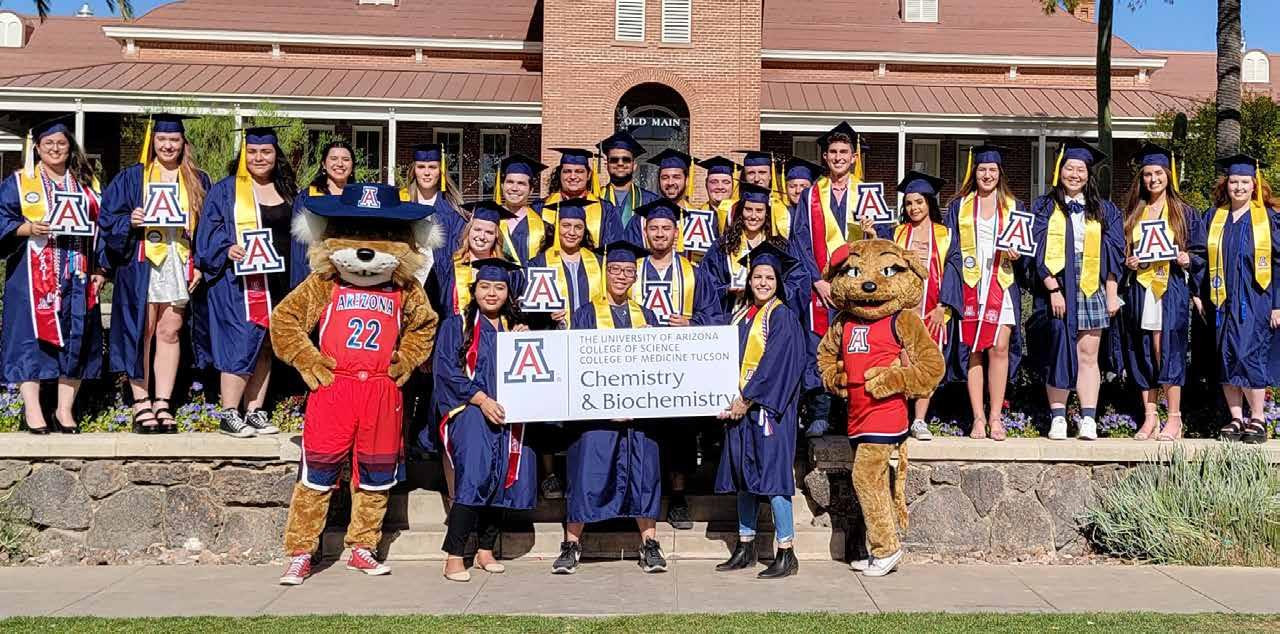

Since I was a sponsored student by Saudi Aramco, a leading oil company based in Saudi Arabia, I am required to work in the oil industry for 5 years. I am going to be working at the Exploration and Petroleum Engineering Center - Advanced Research Center (EXPEC ARC). However, I am very passionate about skincare and the ingredients that make our products work for us. Therefore, I found an online program for a Master of Science in Cosmetic Science. I plan to finish up the program while working for Aramco. I see myself applying for job opportunities globally, and I think France for a couple of years of experience is a good idea. I plan to eventually launch my own brand of both skincare and color cosmetics which would be putting my minor in business administration to use!

THE CATALYST ONLINE | CBC ALUMNI MAGAZINE 40 MAY 2022 & AUGUST 2022
GRADS
Rosa Del Carmen Araujo
BS Biochemistry, 2022 (Greggory Thatcher research group)
My name is Rosa Araujo, and I graduated from the University of Arizona in May of 2022 with a Bachelor of Science in Biochemistry and a minor in French. My undergraduate time with the Department of Chemistry and Biochemistry was an incredible experience especially because of amazing mentors, such as Ms. Olivia Mendoza. Since graduating, I have accepted a position at Banner University Medical Center - Phoenix, more specifically, I work in the neurosurgery department within the Neuroscience Institute. With this opportunity, I can learn invaluable lessons while being mentored by esteemed neurosurgeons. I am grateful for my experience at the University of Arizona as I know it has helped prepare me for all future endeavors.




Max Bloomenstein
BA Biochemistry, 2022
After Graduation, I was lucky enough to step away from the computer screen for a few weeks and for the first time in a long time, go on a vacation with my family to Italy. We spent two weeks traveling through the cities of Cinque Terre, Florence, Venice, and Rome, getting in our steps, embracing the culture and eating gelato for breakfast, lunch, dinner and dessert.
Now back in the States, I have been studying for the optometry school admissions test while working full time as an optometry technician at an office in Scottsdale, while I take the year off to apply to optometry school. As a tech, I pretest the patients as they come in, and among other things, I mainly check visual acuity, peripheral vision, perform OCT scans and prepare everything for the optometrist. I feel extremely lucky to be surrounded by doctors and staff who are more than willing to educate me on techniques and practices that I will hopefully one day be performing myself. The whole process has reinvigorated my passion for eye health and has reassured me that I am on the right path for myself, no matter where the journey takes me.
Ciera Carrillo
BS Biochemistry, BS MCB, 2022 (Jessica Barnes research group)
Since graduating, my plan has been to start working and pursue a master’s degree in the next couple of years.
Sophia Duffett

BA Chemistry, BA French, 2022
When I graduated, I obtained an EMT certification as well as my degree. I plan on working as an EMT for two gap years as well as traveling as much as possible in hopes of putting my French minor to use! I will attend medical school in the fall of 2024.

Ciara Eades
BS Biochemistry, 2022 (Jeong-Yeol Yoon research group)
My plan is to travel for a bit of time and then go into grad school to get a PhD in Biomedical Engineering.
Kelsey Haley
BA Biochemistry, 2022
The University of Arizona provided many opportunities, such as free tutor sessions, that helped me surpass my goals in class. I used those tutor sessions when I was struggling in classes, such as calculus. Additionally, individuals at the U of A are welcoming, which offered opportunities to make friends and study groups. I had a
41 DEPARTMENT OF CHEMISTRY AND BIOCHEMISTRY | FALL 2022
wonderful experience thanks to this. Now that I’ve graduated, my plan is to attend medical school in hopes of becoming a cardiovascular surgeon.
Avani Kumar
BS Biochemistry, 2022 (Pascale Charest research group)
I hope to go to medical school. Right now, I am taking a gap year.
Genesis Taylor Martinez
BS Biochemistry, 2022 (Chad Park research group)
I plan to pursue medical school. I still need to take the MCAT, so I will be taking a gap year. But essentially, I plan on pursuing a career as a medical geneticist in the end.
Kelsey Mason
BS Chemistry, 2022
My name is Kelsey Mason. Graduating in May of 2022 was so bittersweet. I am thankful for the time, experience and opportunities provided to me through the University of Arizona, and while I am sad to have left, I am excited to start a new chapter of my life.
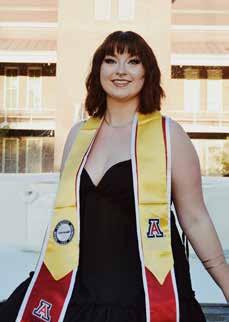


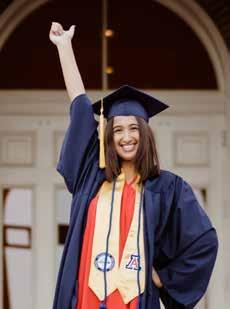
I hope to either work in a research facility, give back by teaching high school chemistry, or begin a career in my dream field as a cosmetic chemist. Being a cosmetic chemist has always been the end goal, and what motivated me through all the lectures and labs.
When I wasn’t studying for my next P-Chem exam or writing a 412 lab report, I enjoyed trying new local restaurants and hanging out with my sorority sisters. During my time at the U of A, I had the opportunity to join a sorority, Alpha Chi Omega, and serve on the executive board and as the chapter president. This was a once in a lifetime experience, and something I will never forget. The U of A has given me so much, and I am so excited to be a proud alumni! Bear Down!
Vivian Mendoza-Leon BS Biochemistry, 2022 (Jacob Schwartz research group)
I would like to thank my advisors, mentors, and family for supporting my pursuit of higher education as a first-generation student. I will continue to gain clinical experience through scribing at a cardiology clinic, study for the MCAT, and apply for medical school.
Alicia D Power
BS Chemistry, 2022 (Douglas Loy research group)
I graduated from the University of Arizona with a BS in Honors Chemistry. Currently, I work for the USDA Carl Hayden Bee Research center as a biological science technician where I perform lipid and fat body analysis on bee colonies to determine their longevity in cold storage. I also work on the pheromonal removal of Varroa mites, which are one of the primary causes of honeybee decline. Throughout my undergraduate career, I also worked alongside Dr. Loy, where I completed my honors thesis on synthesizing hydrogels for the removal of toxic metals in polluted waterways. With this research and work through the USDA, I developed a passion for public service and hope to translate this into a future career in forensic chemistry. The U of A has given me so many amazing opportunities, and I’m excited to finally be a proud alumni! Bear Down!
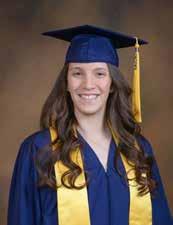
THE CATALYST ONLINE | CBC ALUMNI MAGAZINE 42
Alejandra Betancourt Ramirez
BS Chemistry, BA Spanish, 2022
I will be working at BASF, and I will be starting my master’s degree in January of 2023.
Lindsey Kaye Reed
BS Chemistry, 2022
I began work as a lab tech for a local company specializing in nutrition and dietary supplements.
Rorie Robinson
BS Biochemistry, 2022
Rorie was involved in numerous sectors of The University of Arizona as an undergraduate. She worked in the Vanderah Lab, was a member of Kappa Alpha Theta, and the president of the women’s club water polo team. Rorie will be attending The University of Arizona College of Medicine-Tucson this coming fall semester.

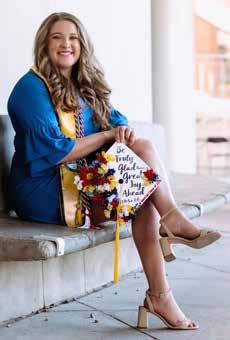


Kiah Sleiman
(2022 Outstanding Senior)
BS Biochemistry, 2022 (Joyce Wu research group)
My parents met during their time at the University of Arizona, and so I was raised a Wildcat. In deciding where I wanted to go after high school, I was conflicted about where to go, with choices between an adventure in another state, or continuing the family tradition of being a Wildcat. My senior year of high school, I was able to join a lab at the University of Arizona and venture into the world of research, and once I started, choosing to stay was easy. I took the first semester to declare my majors, French and biochemistry, and was astonished by the support I had from the advising offices despite having started as an undecided honors student.

I have grown so much as a person because of the experiences I had at UArizona, from preceptoring and peer mentoring to working full time in the lab over the summer with the Undergraduate Biology Research Program. The advising team in both the French and CBC departments are incredible, but being an ambassador for the CBC department truly helped me to grow in confidence and gave me a prime opportunity to engage with the CBC community. I have made best friends during my time, and I am so happy that I decided to stay in Tucson for college while majoring in biochemistry. I learned so much about the subject and pursued questions I never would have considered before, and I can apply my degree in so many different ways. I have friends going to medical school, veterinary school and law school. Some of them are going directly into industry or academic labs. I came in looking at a path in forensic science and am now continuing my education at Baylor University to get a PhD in Biology. My experience at the University of Arizona in the CBC department was truly one of support and encouragement to pursue the many opportunities made available to us, and one of a community that cared about each other and did their best to get through the toughest times in one piece and together.
Martin Soto
BS Biochemistry, BS Biomedical Engineering, 2022
I moved to Boston to continue working as a bioinformatics analyst for Variantyx Inc., and then work towards a MS in Genetics after a year.
43 DEPARTMENT OF CHEMISTRY AND BIOCHEMISTRY | FALL 2022
Joshua Stanton
BS Biochemistry, BS MCB, 2022
I stayed at the U of A for graduate school. I am the guinea pig for a new hybrid program in which I will receive a Master’s Degree in Perfusion Sciences and a PhD in Medical Pharmacology by the end of (finger’s crossed) five years!
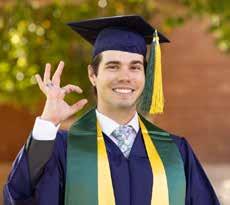
Trevor Tankersley
BS Biochemistry, BS Physiology & Medical Sciences, 2022
Trevor has been awarded the 2022 Wildcat Excellence Award and the Dean’s Distinction Award. After graduation, Trevor began working as a research technician in the Nikolich-Žugich lab, further honing his skills as a researcher. He then hopes to apply to graduate school, eventually obtaining a Doctorate in Immunobiology.
Sophia J. Volpe
BS Biochemistry, 2022 (Eugene Chang research group)
I am taking a gap year to continue my research work in the Chang lab and gain valuable experience before applying to medical school in the fall. Thanks for all your support, CBC!
Ciara
Zak (2022 Excellence in Research, Senior Award)
BA Biochemistry, BS MCB, 2022 (Michael Marty research group)

I started attending the University of Arizona College of Medicine – Tucson in July of 2022.
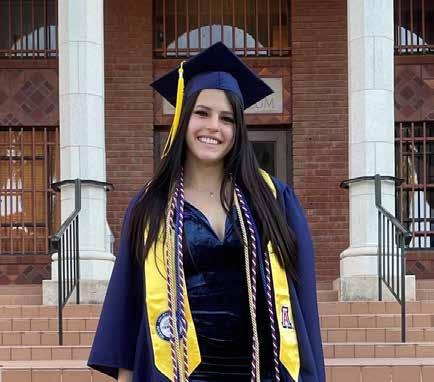

THE CATALYST ONLINE | CBC ALUMNI MAGAZINE 44
STUDENT ADVENTURES
Tasmia Ahmed and Paola Cruz Flores

This past summer, we had this amazing opportunity to visit Ireland to attend a conference. The whole trip was 2-weeks long. The first week we spent in the conference, and the following week we roamed all around Ireland and visited some very cool places.
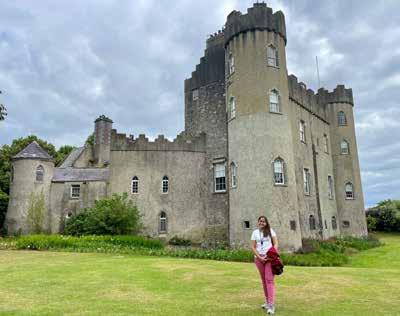
Federation of American Societies for Experimental Biology (FASEB) organized the conference entitled: “The TGF-β Superfamily Conference: Signaling in Development and Disease,” that took place in Malahide, Ireland, from July 17th to July 21st, 2022. Lee lab is fundamentally a TGFβ signaling focused lab. As the conference was exploring specifically the field of TGFβ signaling, it was an extremely beneficial experience for both our professional and academic development.
We received the GPSC travel grant and a NIH travel award for attending the conference. We both have presented a short talk and a poster where we presented our research from our recent publications. For our short talks we both won the ‘outstanding short talk’ awards in the category of talks presented by the graduate students.
It was very exciting to meet some of the greatest researchers in the TGFβ field whose work we have been avidly following, citing and have been collaborating with but had never got the chance to meet them in person until this conference. This conference was an excellent platform to establish ourselves as young researchers and has helped us incredibly to learn from the top scientists and our peers from different parts of the world.
The week following the conference, we spent in enjoying the picturesque scenic beauty of Ireland! Words or pictures cannot justify the beauty and the serenity of this country. We have visited couple of the classic tourist attraction spots such as The Cliffs of Moher, Aran’s Island, Killarney National Park, The Rink of Kerry and the Dublin city especially the Trinity College. We loved the castles especially because of their histories and stories related to them. Also loved the road trips that we took; those journeys were fantastic scenic drives in itself.
The drives by the mighty Atlantic along with the beautiful weather has made the journey very refreshing and enjoyable. We have learned a lot about the Irish culture, food, art, history, and had a very fond memory to participate in an Irish dance with the local dancers!
The whole experience in Ireland will certainly be one of our best memories and we will always cherish them for the fabulous time we spent there.
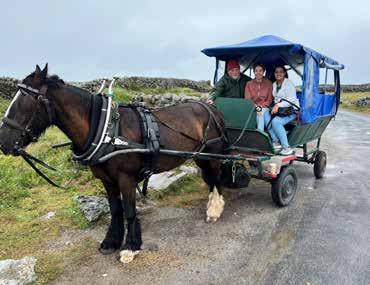
45 DEPARTMENT OF CHEMISTRY AND BIOCHEMISTRY | FALL 2022
Ellie Browne
I spent most of my time at MIT working in Dr. Laura Kiessling’s lab, where I developed and tested chemical probes to study bacterial cell envelopes. I was grateful to learn about a wide variety of techniques in organic synthesis, biochemistry, and microbiology.
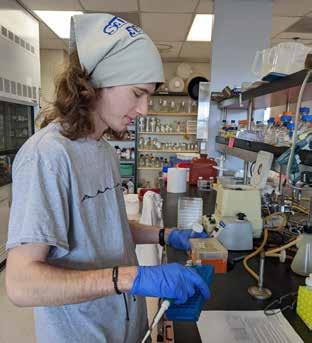

MSRP-Bio also provided opportunities to meet professors, attend mini-conferences, and present our work. Outside of the program, I enjoyed exploring Boston and relaxing with my cohort and lab mates. I am so glad I took this opportunity, and I highly recommend it!

Rachel Hurley
This past summer I participated in the Global Medcats study abroad trip. I travelled to the small town of Mérida, Spain, where I spent four days a week shadowing doctors in a hospital and spent my weekends traveling throughout Spain and Portugal. Upon my arrival in Spain, I met 12 other women partaking in the study abroad trip who would soon become some of my closest friends.
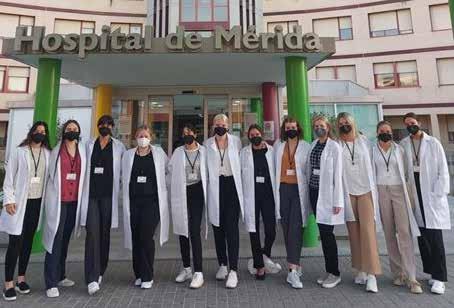
Caleb Knoecek
As part of the Dorrance Scholarship Programs, I have had the wonderful opportunity to study abroad across France and Italy during the fall 2022 semester. During my trip, I visited art museums and historical monuments to develop an understanding of classical civilizations and art history.
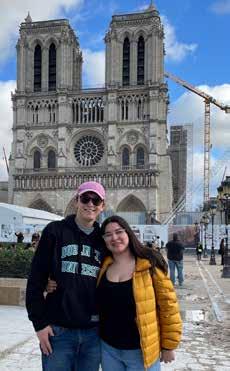


As a biochemistry and molecular and cellular biology double major, studying the humanities has allowed me to develop a unique interdisciplinary mindset that I am excited to apply to future studies and careers.
In the upcoming spring 2023 semester, I am planning on studying abroad in Alcalá de Henares in Spain to further my Spanish language skills and pursue a third major in Spanish.
Nick Mortimore
I did research this past summer for the Beckman Program in the Buchan Lab. Throughout the summer, I was a UBRP Small Group Leader, where I mentored new UBRP students in undergraduate research. Unassociated with the Beckman Program, I was also elected as the UBRP Ambassador President where I have led and planned activities/field trips for UBRP students.
Recently, I travelled to CalTech in Pasadena, California, to attend the Annual Beckman Symposium, where I met with fellow Beckman awardees and program organizers to talk about research and the continuation of the Beckman legacy. I did not present at this conference, but I will present at the one held next year.
THE CATALYST ONLINE | CBC ALUMNI MAGAZINE 46
Additionally, I went to Flagstaff for a retreat with the Buchan Lab to talk about research and to familiarize myself with my fellow lab members. In terms of my research, I am heading my own project with direct mentorship from Dr. Buchan to construct a screen in yeast—looking for the effects of 3’UTRs on Protein-Protein Interaction strength.
Madison O’Callaghan
Having spent two months in Europe this past summer, I am excited to be back at U of A having gained so many new experiences and friendships. I took a three-week sculpture course for my studio art minor in Aix-en-Provence, France, putting my French minor to use for the first time outside of the states. I was housed with another UA student by my French hostess, Anne-Marie, who always made sure to offer a glass of Provence Rosé with dinner in her chic, picturesque home. With my new friends I got to kayak in the Gorges du Verdon, hike in the calanques of Cassis, visit the infamous lavender fields, mosey through art museums, and so much more.

In my sculpture course, I couldn’t help but notice how art and science depend on one another as we worked with various mixtures of plastilina and a range of temperatures fighting against us (hence the melted head of my self-portrait!). Taking opportunities such as this has only enhanced my experience with my biochemistry degree and helps me to see science throughout the world around us. My time at UA has been an amazing journey as I prepare to go to dental school, where art and science will continue to merge constantly. Thank you to the U of A for facilitating such a special opportunity that leaves me more well-rounded and excited to continue on with my career!
Anna Ramsook
My name is Anna Ramsook, and I’m a junior at the U of A! I am majoring in biochemistry and minoring in human health and values. I am also a CBC ambassador and peer mentor! This past summer, I studied abroad in London through UA’s partner, St Mary’s University. I spent 6 weeks in London and took a class called Renaissance London. I loved this class because I got to learn about the history of London while exploring the city on my daily adventures.



Over the course of 6 weeks, I did all of the classic tourist activities such as visiting Buckingham Palace and riding the London Eye. I also explored some local favorites such as Green Park and the Wimbledon Championships. My weekends consisted of traveling to see the White Cliffs of Dover, the beach in Brighton, Edinburgh Castle in Scotland, and the Eiffel Tower in Paris, France!
My time abroad allowed me to see so many new things and learn about British culture and customs. I also gained confidence in navigating a new place through boats, trains, planes,

47 DEPARTMENT OF CHEMISTRY AND BIOCHEMISTRY | FALL 2022
and, of course, the underground. “Mind the Gap” became my favorite phrase! This was the best way I could have spent my summer, and I cannot wait to study abroad again next summer!
Beverly Ru

I am a fifth-year graduate student in Dr. Andrei Sanov’s lab. I was given the opportunity to do a summer internship at Space Dynamics Laboratory (SDL) under my supervisor, Bret Maughan, a previous graduate student at U of A. There I worked on high-vacuum systems and analyzed materials given by DoD contractors. Everyone that I worked with and met was wonderful, friendly, and welcoming.
Outside of work, I spent my time exploring Logan, Utah. I walked my dog, Luna, around the neighborhood and enjoyed the greenery. I picked up indoor rock climbing again. In addition, I went outdoor rock climbing with coworkers and other employees for the first time. I went hiking with friends and, of course, Luna. I kayaked in a reservoir, which was quite relaxing and fun. I explored Ogden and Salt Lake City, Utah. Overall, my experience at SDL and Utah was filled with wonderful and unforgettable memories that I will always cherish.


THE CATALYST ONLINE | CBC ALUMNI MAGAZINE 48
RETIREES
Marc Tischler
Professor Emeritus Chemistry & Biochemistry
Plans for Retirement
My wife, Jan, and I are participating in animal volunteer activities through the Humane Society of Southern Arizona (HSSAZ) and Happy Equine Acres Rescue and Therapy (HEART) of Tucson. Through HSSAZ our youngest Maine Coon cat (2 in Feb 2023), Larry, is certified for Pet Therapy with us as a team. Larry is now 20 pounds and still growing. We mostly visit nursing and memory care facilities with Larry. The residents, staff and visitors interact with Larry (many pet him). The residents look forward to our visits; Larry brings a smile to their faces. Larry also does monthly visits with UA students, through the Dean of Students office, who receive ‘pet therapy’ from him. We also participate in HSSAZ fund-raising activities. Additionally, the first Sunday of each month we assist with dog and cat food distribution to Tucson families in need. Through HEART we provide daily care for two rescue miniature horses (BlackBerry and Eagle) and a pony (Calvin).
Our family includes four grandchildren and four Maine Coon cats (15-20 pounds). We travel to see family and friends, or they visit us in Tucson. Using my Professor Emeritus status, I am continuing to mentor undergraduate and medical students, as well as to assist in teaching the medical students.

Accomplishments
• 1979 to 1985 – Assistant Professor of Biochemistry
• 1982 to 1987 — Established Investigator of the American Heart Association
• 1985 to 1990 – Associate Professor of Biochemistry
• 1990 to 1991 — President, American Society for Gravitational and Space Biology
• 1990 to 2009 – Professor of Biochemistry
• 1991 – Physiological Anatomical Rodent Experiment -1 on Space Shuttle
• 1992 –Distinguished Service award, American Society for Gravitational & Space Biology
• 1992 – Graduate College Award for Academic and Professional Presentations program
• 1993 to 1994 – Dean’s Teaching Scholar, College of Medicine
• 1995 to 1999 – Interim Head of Biochemistry
• 1995 — Furrow Award — Excellence in Basic Science Teaching for Medical Students
• 1995, 2003, 2004 — Basic Science Educator of the Year, College of Medicine
• 1995 to 2021 – Director Medical Student Bridge Program
• 1995, 1996 – BRIC-04/BRIC-07 Space shuttle experiments
• 1997 –Furrow Award — Innovation in Medical Teaching
• 1999 to 2009 – Associate Head of Biochemistry & Molecular Biophysics
• 1999 to 2021 –Maximizing Access to Research Careers program (Director 1999-2012; Associate Director 20122016; Director 2016-2022)
• 2002 — Distinguished Teaching, College of Science
• 2005 — Life Time Basic Medical Science Educator Award, College of Medicine
• 2006 to 2021 – Medical Biochemistry and Nutrition Discipline Director, College of Medicine
• 2008 to 2021 – Academy of Medical Education Scholars, College of Medicine
• 2009 to 2022 – Professor of Chemistry & Biochemistry
• 2010 — Peter Likins Inclusive Excellence Award
• 2010, 2011, 2012, 2013 — Graduating Medical Class Outstanding Teacher in Basic Sciences
Ihave worked with Marc for almost 23 years in the Maximizing Access to Research Careers (MARC) Program. He has had a direct and positive impact on so many students in and outside the program. Marc always made himself available to help any student who was willing to be helped or receive advice. His unwavering dedication and attention to the students who came through the UA MARC Program certainly made it the successful program it is today.
—Cindy Neal, Assistant Director, MARC Program
49 DEPARTMENT OF CHEMISTRY AND BIOCHEMISTRY | FALL 2022
Ellie Warder Program Coordinator
Looking back at my 41 years with the department, there were 2 milestones that stand out as being memorable as well as important. The first instance was shortly after I started working for the Department of Biochemistry in 1981. At that time, the department was spread around campus, with department members located in the Arizona Health Sciences Center, the New Chemistry Building (now called the Carl S. Marvel Laboratories), as well as locations in the College of Agriculture. The plan was to pull the entire department together in the Biological Sciences West building, which happened in 1982 after 3 floors were added on the west side of the existing building.
Settling into BSW was trying at times. For the first few months, whenever the wind blew from the wrong direction, it would set off the fire alarms. Shortly after we moved in, a real fire broke out in the air conditioning ducts of one of the 3rd floor offices. Although there was plenty of space in BSW at first, after hiring several new faculty members, space became exceedingly tight, causing folks to look for creative ways to better utilize the available space. This is why the third and fourth floor hallways are partially blocked off.
The second milestone that stands out is when the Department of Biochemistry merged with the Department of Chemistry in 2009, creating the Department of Chemistry and Biochemistry (CBC).
I’ve been enjoying retirement since the end of 2021. I recently entered my cranberry salsa in the 2022 Arizona State Fair and won 1st place!!
For the nearly two decades that I worked in Biochemistry (and later Chemistry and Biochemistry), Ellie Warder provided consistency, structure, endless advice, and a listening ear for the teachers who were working in the General Biology master’s program (later the MS Program in Natural Sciences). She was their first contact when they contacted the program to learn about applying, and the person who helped them understand the flow and requirements of the program. Along the way, she became a friend, mentor, and consistent touchstone for the teachers in the program. She was our public face, and the teachers often expressed their thanks for her tireless advocacy.
When I came to Biochemistry in 1998 to lead the MS Program in General Biology, it was my first “grown-up” job in academic. Ellie provided invaluable continuity and shared information about the program, the department, and the personalities of all involved, helping me to grow into the position. Her “students first” approach shaped my own, and I am grateful for the lessons she taught me.
—Lisa K. Elfring, Associate Vice Provost, Instruction and Assessment; Specialist, Molecular and Cellular Biology

THE CATALYST ONLINE | CBC ALUMNI MAGAZINE 50
IN MEMORIAM
PEOPLE WE HAVE LOST
Gisele (Rosin) Green MS Chemistry, 1961 d. May 11, 2022
Gisele Green passed away suddenly after a long illness. Born in France, she escaped the Nazi invasion as a young child and settled with her family in New York City. The family later moved to New Jersey, where Gisele attended Drew University. It was there, in the Chemistry Department, that she met her husband-to-be, Maurice. The chemistry between them lasted for 66 years.
Gisele earned an MS degree in Chemistry from the University of Arizona with Professor Cornelius Steelink in 1961 and then worked as a research assistant with Professor Gordon Tollin. After raising two daughters, she earned an MS in Microbiology at the University of Maryland. The family spent a decade in Israel and then moved to California, where Gisele worked in several research positions, notably at Stanford, Clontech and Becton Dickinson.
Gisele loved traveling and the outdoors. She and Maury ventured far and wide, from Alaska to New Zealand. They especially enjoyed their visits to Kauai. At the seaside, Gisele was truly in her element.
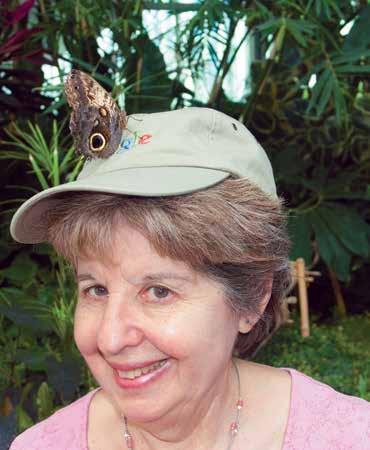
Gisele is survived by her husband, Dr. Maurice Green of Palo Alto, her daughters, Sarah Green (Bill Wood) of Arcata and Tami (Yehuda) Demayo of San Jose, her sister, Naomi (Norman) Feinstein of Netanya, Israel, her brother Abe (Nancy) Rosin of Tucson, Arizona, her three grandchildren, Tahv, Matan, and Shalev Demayo and a large extended family in Israel and the U.S.

May her memory be as a blessing.
Margaret “Marty” Ann Fox Yslas d. January 16, 2022
Marty (Margaret) Yslas passed away on January 16, 2022, at the Tucson Medical Center at the age of 78. She was born June 27, 1943, in International Falls, Minnesota. Although she grew up in International Falls and returned regularly, she graduated from Rincon High School in Tucson, Arizona where she remained and raised her children. She met and married Max Yslas in 1972 whom she referred to as her “Prince Charming.” She spent many years working in grocery, at Sears, and later retired from the University of Arizona. Marty was the smiling face greeting you at the BSW 3rd floor lobby. Her husband Max was a mail courier for the department, come rain or shine.
Marty also owned her own business sewing wedding gowns and formal wear. She loved gardening, quilting, baking, and knitting and never could pass up a craft fair. Her joy was her involvement in any activities her children and grandchildren participated in including youth football, theatre, softball, baseball, and music. She could be found in the front row at as many events, tournaments, games, and productions as humanly possible. Her home and her heart remained open to anyone who needed it.
She and Max spent their summers in International Falls, Minnesota where they attended weekly church services at Holy Trinity Episcopal Church and were active in the community assisting Ruby’s Pantry and Backus Community Center.
Surviving in addition to her husband, Max, are her three children, ten grandchildren, 11 great-grandchildren, many nieces and nephews and countless others who call her mom or nana. All will miss our time with her playing cards, sharing meals, laughing, and generally just spending time together. They will even miss playing Chinese Checkers with her, even though no one stood a chance at beating her.
51 DEPARTMENT OF CHEMISTRY AND BIOCHEMISTRY | FALL 2022
2022 IN PICTURES
CBC GRADUATE STUDENT RESEARCH SYMPOSIUM



2022 UA HOMECOMING CHEMISTRY
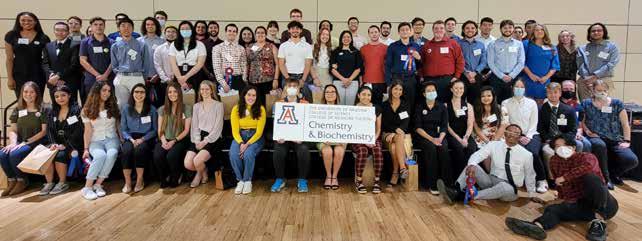


MAY 2022 CBC CONVOCATION

COLLEGE OF SCIENCE COMMENCEMENT
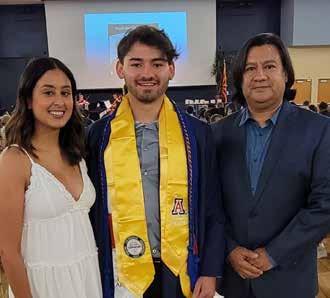

THE CATALYST ONLINE | CBC ALUMNI MAGAZINE 52
Sammi Rokey, Alessandra Fistrovich, Timothy Chavez, Kevin Schofield
MAGIC SHOW Kierra Garland provides a light show
Jewett Lab members: Anjalee Wijetunge, Natasha Cornejo, Dr. John Jewett, Holly Sofka
Brittany Stankavich, Bismark Amofah and Zhihan Wang
New CBC PhDs: Clayton Curtis, Tarek H. El Assaad, Samuel Sugarman, Blake Seaton, Alexander Marciniak, Keerthana Kesavan, Zhihan Wang, Bismark Amofah, Jose Veleta, Anthony Baldo, Sara Zachritz
Wilbur; Trevor Tankersley, Robert Logan Nugent
Senior Awardee; Kiah Sleiman, CBC Outstanding Senior; Wilma Matheo Herrera (center) and family
CBC POSTER FAIR Cristian Chavira
CBC Poster Fair participants
CBC AMBASSADORS
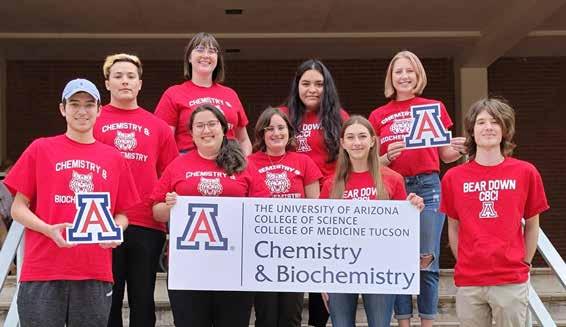
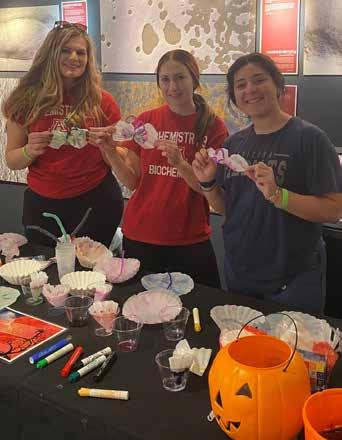

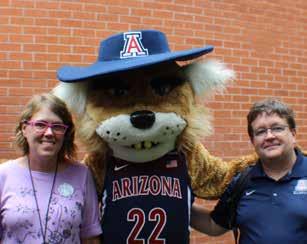
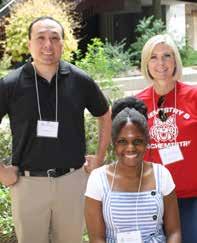


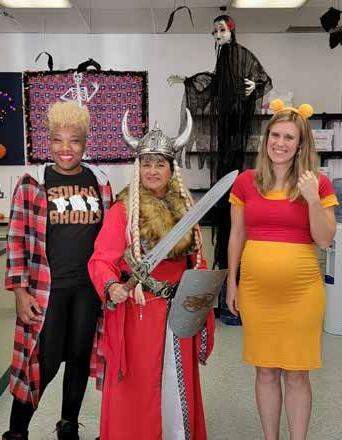
Front

53 DEPARTMENT OF CHEMISTRY AND BIOCHEMISTRY | FALL 2022
FALL 2022 CBC WELCOME BACK BREAKFAST Roy Sanchez, Lisa Arrotta, Ashley McKinley
COLLEGE OF SCIENCE NEW STUDENT WELCOME EVENT Carleen De Armon, Wilbur, Debra Armand-Cade Dee Belle-Oudry, Wilbur and Craig Aspinwall
WHITE COAT CEREMONY FOR NEW CBC GRADUATE STUDENTS
Debra Armand-Cade, Olivia Mendoza, Carleen De Armon, Advising Halloween 2022
PAWS Graduate student members: Lindsey Holmen, Alessandra Fistrovich, Megan Laham at Spooktacular Science at Flandrau
CBC HALLOWEEN
CBC major, Vanessa Addison, Homecoming Queen, and Physiology & Med Sciences major Brandon Fuentes Homecoming King, for 2022
Top row: Franky Torres, Katie Baldwin, Rosa Araujo, Madison O’Callaghan
row: Anthony DiGirolamo, Kiah Sleiman, Hillary Schiff, Shayna Maddern, Nick Mortimore











 By Neal Armstrong
By Neal Armstrong

















































































































































































